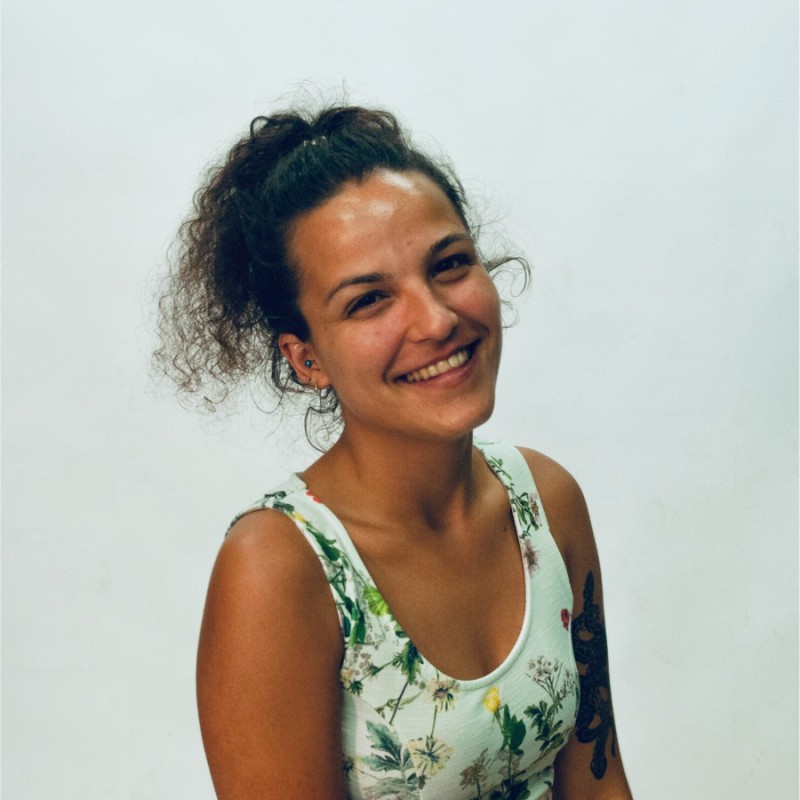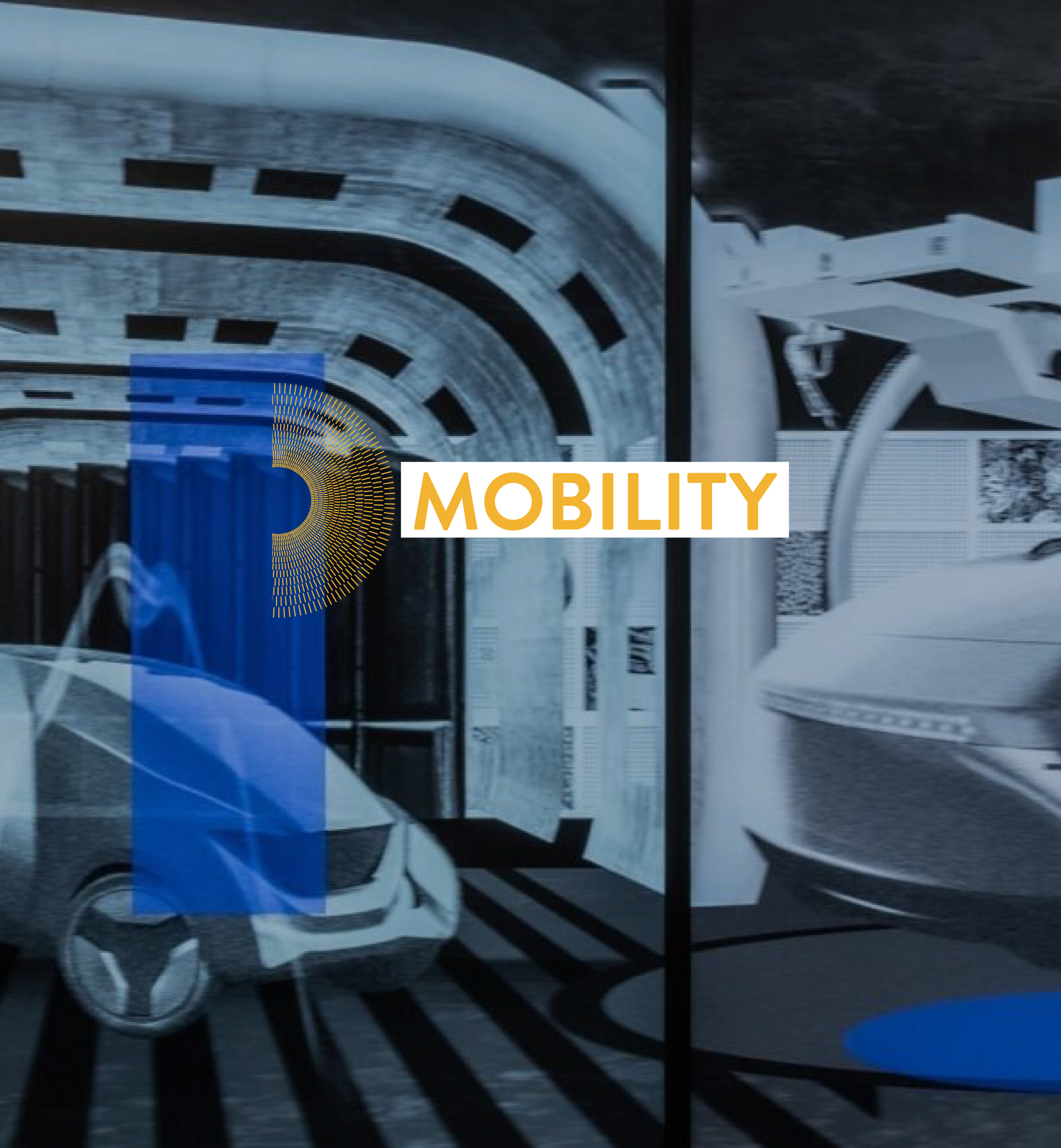
Author: admin

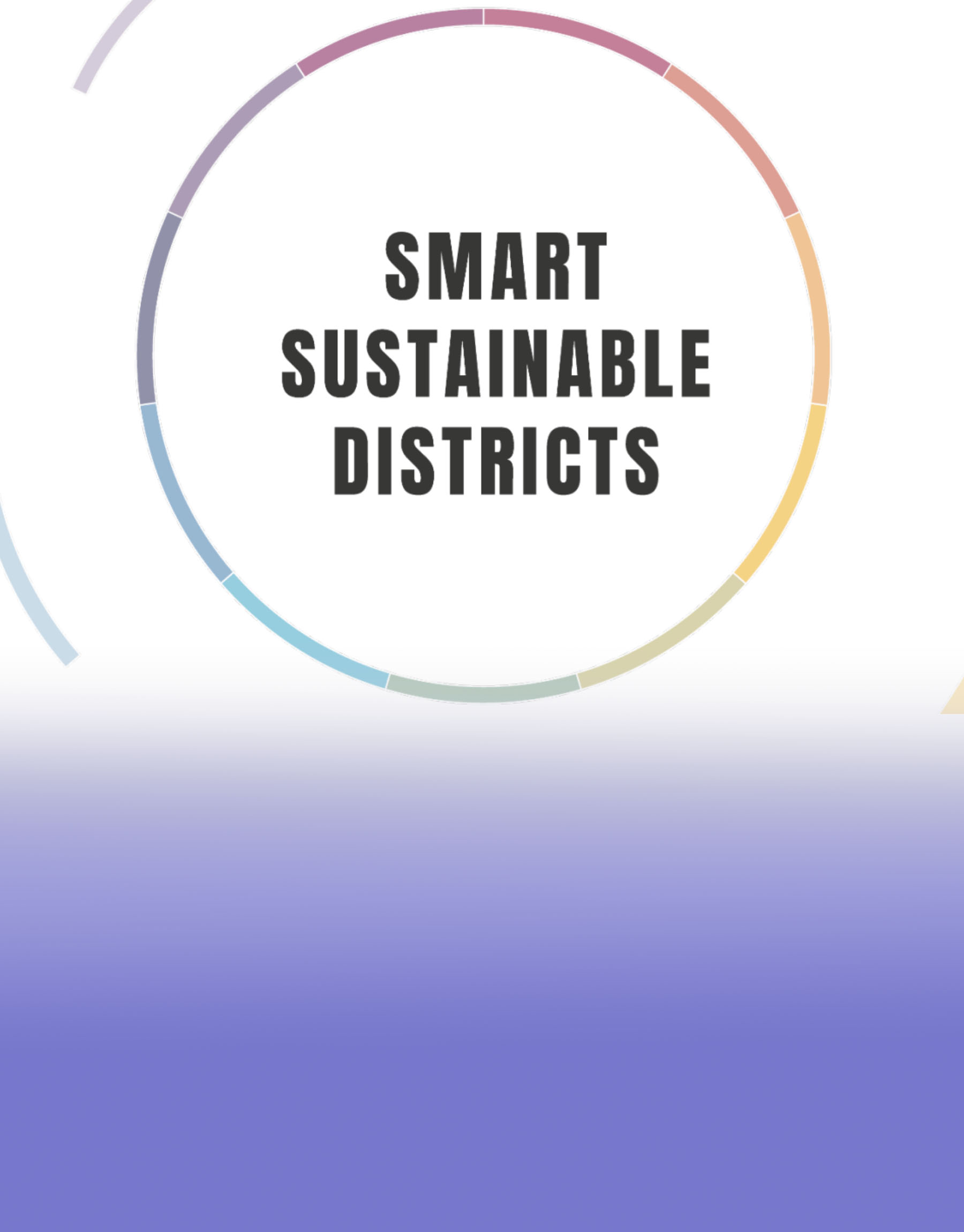
The White Paper SSD – Smart Sustainable District
The White Paper SSD – Smart Sustainable Districts has been published: the project, promoted by Politecnico di Milano and coordinated byConsorzio Poliedra, aims to suggest actions for thesustainable development, the ecologic transition, and the resilience of places and communities at a local scale, by defining a series of paths, actions and tools to deal with urban transformations at a local scale, considering sustainable and smart solutions.
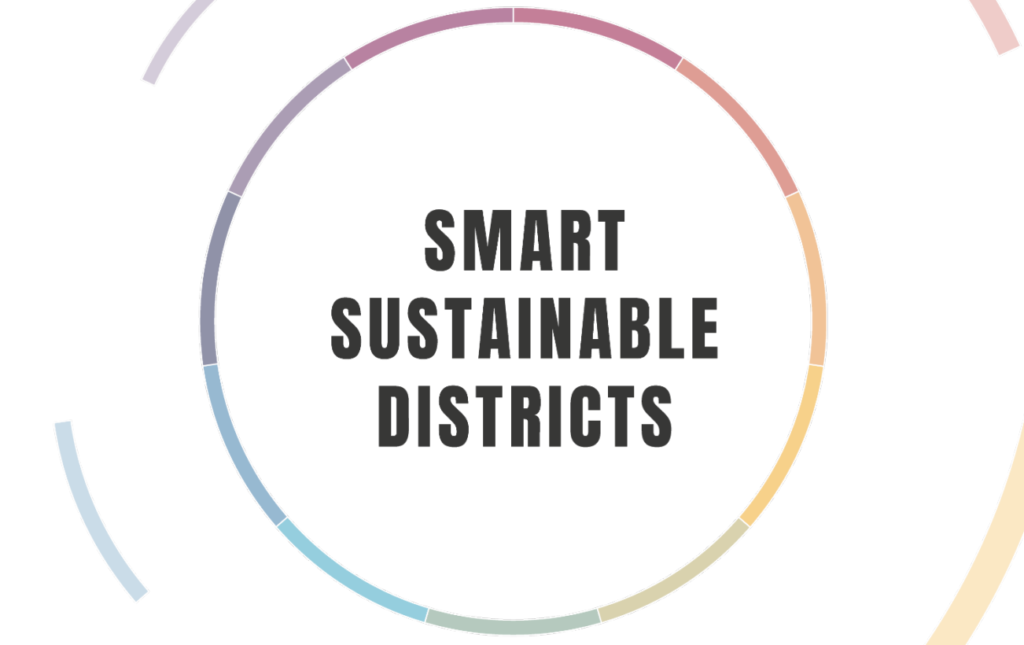
The White Paper drafts some practical guidelines to deal with the difference phases of urban transformation during processes of regeneration and ecological transition. It puts together technical-scientific approaches together with humanistic-social ones, proposing methods and solutions that works together at a different scale, considering material and immaterial assets and suggesting how to direct urban regeneration processes, coordinating different plans, proposing integrated tools to fulfil aggregated positive effects.
SSD - Smart Sustainable Districts project started in 2021, involving more than 100 researchers from all the departments and consortium of the University ( Polimi SystemIn particular, it speaks to local authorities and all the different figures active in urban and districts regeneration.
The project is one of the research activities that the Politecnico di Milano undertakes to contribute to the achievement of sustainable development and, in particular, is among the activites related to the Sustainable Development Goal number 11 of the UN 2030 Agenda: "Sustainable Cities and Communities”.
Leggi anche su: polimi.it
Credits home/header: Poliedra
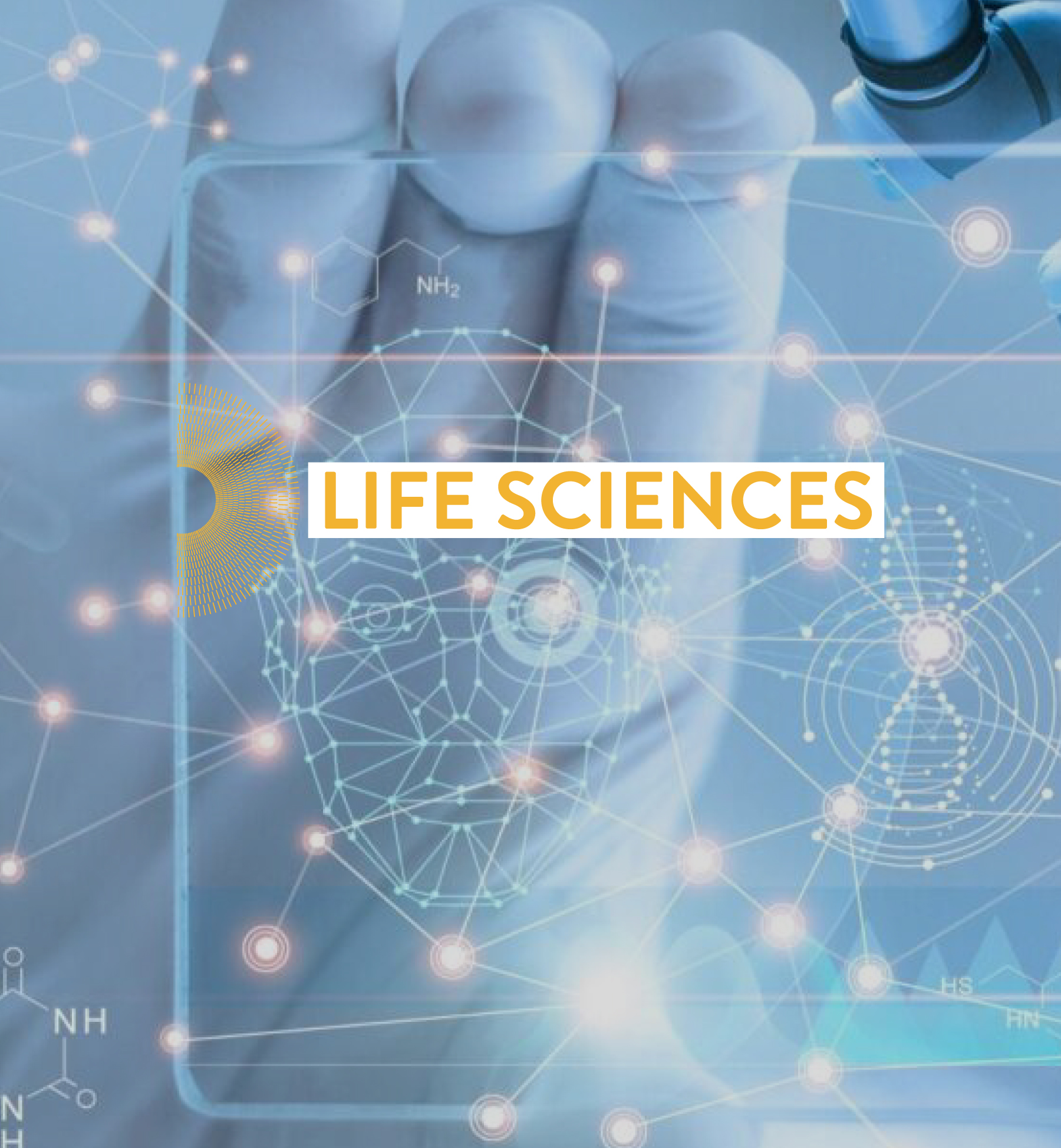
New ONCO-TECH-LAB
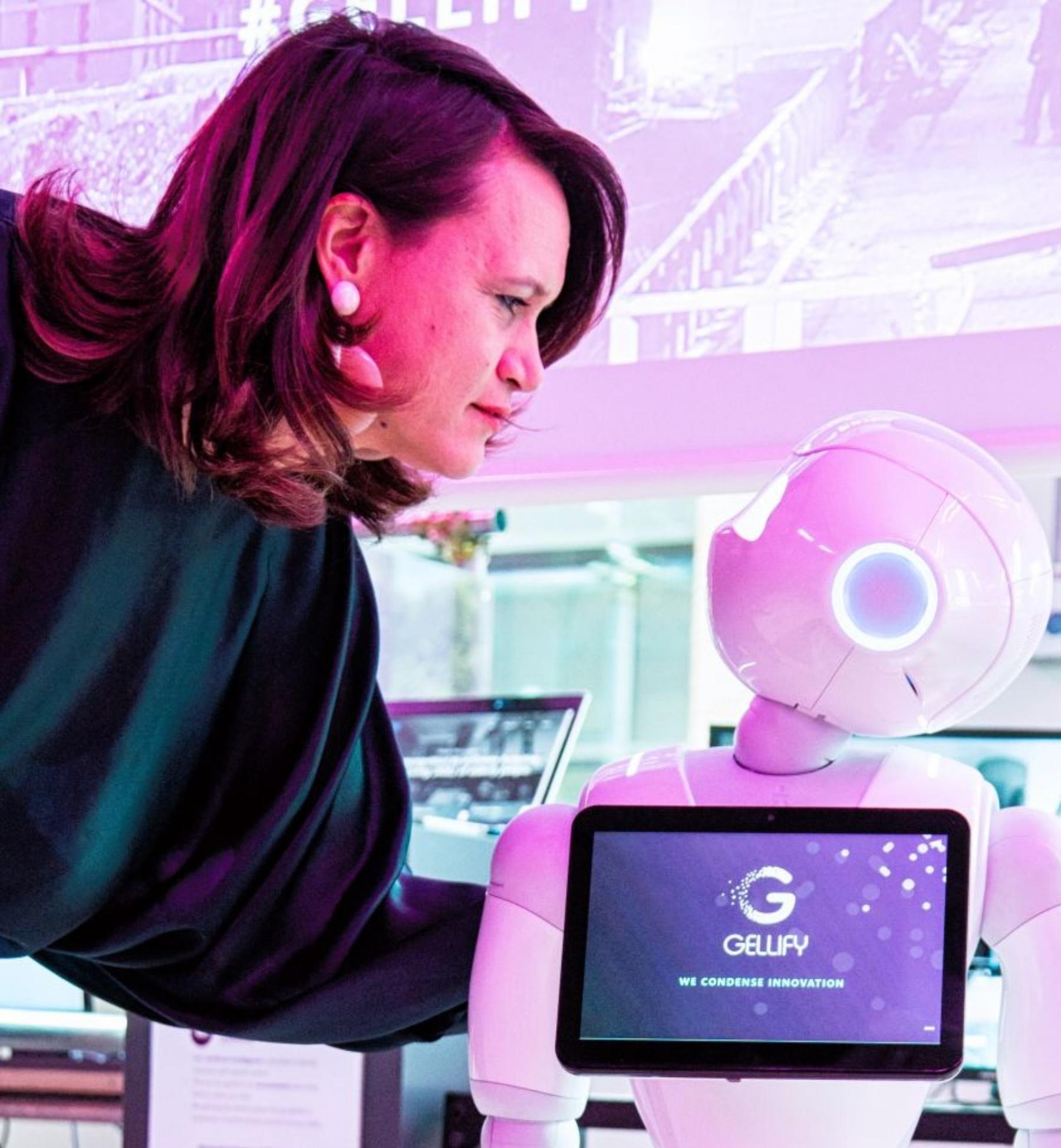
“Emotions and engineering” by Alumna Lucia Chierchia
Engineering and emotions: they are seemingly two worlds that cannot meet, but not for Lucia Chierchia. Interviewed by Il Sole24oreChierchia - Alumna in mechanical engineering in 1999 - describes the passion that drove her to pursue the engineering career that has accompanied her since she was a child:
“You get excited about something beautiful that makes you feel good, that creates value. Sometimes there seems to be a dichotomy between the whole world of art, for example, a world that is pure emotion, and engineering. Instead, during my studies and my career, I felt the same emotions that you feel about a work of art ".
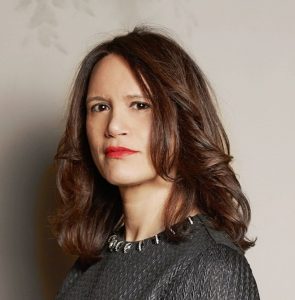
She had also talked about it with us, in the book ALUMNAE – Ingegnere e Tecnologie:
““The passion, the enthusiasm, the intuition that “that is the way for us” is something that comes from our history. In high school I did classical studies, already knowing, however, that I would study engineering: it was my dream since I was a child. That's why my mother called me Grisù like the friendly little dragon [protagonist of a 1970s Italian animated cartoon] who dreamed of being a firefighter, because I kept repeating: «When I grow up, I'll be an engineer!» ”.
After graduating from the Politec nico di Milano, the Alumna started working in the aerospace sector, and then held managerial roles in Whirpool and Electrolux. Today she is a market ambassador & open innovation ecosystems lead in Gellify, the B2B innovation platform that invests directly in startups and scaleups, accompanying them in entering the market. The goal is to put them in contact with companies with the will to innovate, which help them validate their technological solution, implementing it in mature industrial contexts.
For Chierchia in particular digital innovation requires creativity, a characteristic that is often "very strong in female profiles". In fact, companies are increasingly looking for women who “are prone to empathy and interpersonal skills that allow them to move even in constantly evolving contexts, as well as to learn quickly”.
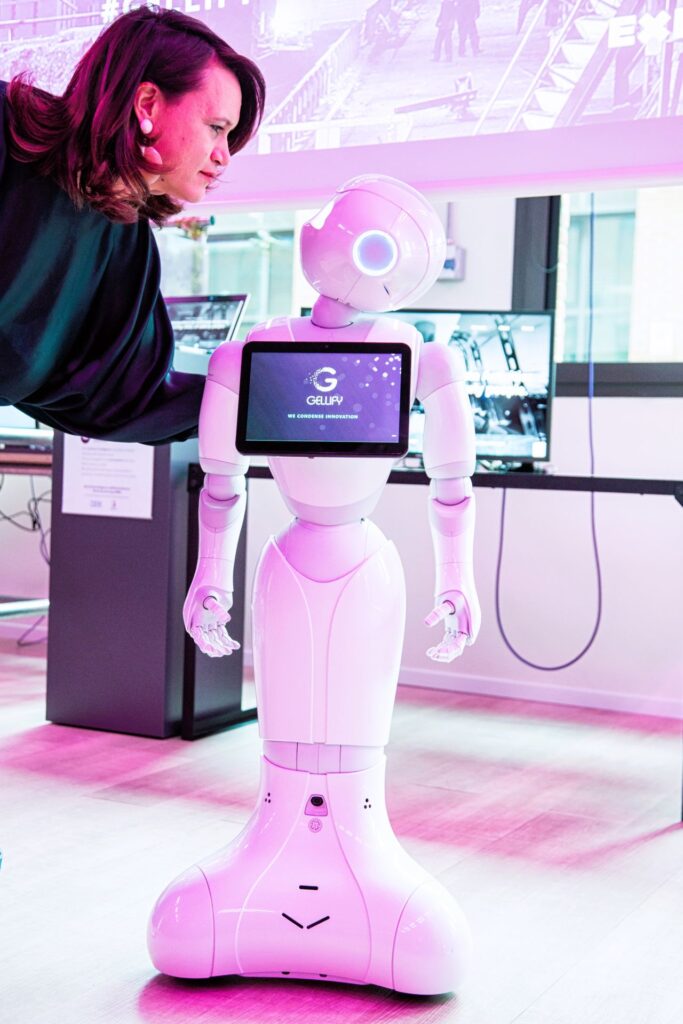
However, it is here in the workplace (and especially in Italy) that women often struggle to make a career in the STEM environment: "there are still too few". This is a reality that unfortunately also exists in young working environments like startups, the Alumna underlined in the interview, where backwardness is also found in young executives.
It is fundamental, she argues, to ensure that change also moves through the men. It is they who, together with the women who are already implementing change, must not be silent on the subject. “The problem is not only with young women but also men: if it becomes a challenge only for the women we will never make it. In some contexts I have seen colleagues who took a stand, that's what makes the difference, not keeping quiet. I've never been silent, everyone should do it".
But how do we encourage girls to follow their STEM inclinations?
“Girls are already in love with STEM subjects. We need to listen to these emotions. But they lack support. Numbers are important for awareness, but the real problem in some contexts is something else: women in some cases are not supported making their choice. If you feel strange doing engineering there is something wrong with your family, not with you ”.
The numbers in fact speak for themselves: girls who choose STEM courses at university represent only 18% of the total, while at the Politecnico di Milano this rises to 23.6% for three-year degrees and 27.3% for master's degrees (source: Gender balance 2021).
Even today, unfortunately, technical professions such as engineering are considered a "natural habitat" for men and an achievement for women - as the Vice Rector Sciuto also states in the book Alumnae - Ingegnere e Tecnologie -. Often, embarking on an engineering career requires girls to be extra motivated due to assumed prejudices and models imposed by a conformist society.
The university support system is, in this context, fundamental: for this reason the Politecnico di Milano has created the Girls@Polimi, which, for the entire three-year course, will support girls who choose to study Engineering at the Politecnico di Milano, attending courses with a low female presence (Aerospace, Automation, Electrical, Electronic, IT, Mechanical and Industrial Production Engineering).
Women who study STEM subjects and create startups are, in fact, still forced to answer questions on how to reconcile family and career, the Alumna continued in the interview. The problem, therefore, also exists for those professionals who decide to invest in their ideas by creating a new business. Chierchia’s examples are concrete: for her there are 2 reasons behind the still difficult presence of women in this world:: "The first obstacle is the STEM environment, the second is the chauvinism of the investment world" concluded the engineer.
The solution? Encourage girls to study and wait: “change can and must pass through to the new generations”.
By supporting the GIRLS @ POLIMI project you can contribute together with other donors to create scholarships to support girls enrolling in engineering degree courses with low female attendance. Donate now .
Credits home/header: https://www.gellify.com/it/

The gentle star: the interview with Amalia Ercoli-Finzi
We are in the B12 building of the Politecnico, in the heart of the Bovisa campus. I am meeting Professor Amalia Ercoli Finzi on the second floor. The building is a maze: in fact I got lost, she had to guide me there with her mobile phone, as if I were a probe that had gone off course. She is a petite lady with an elegant, kind and curious manner. She is also one of Italy’s leading scientists. And yet, one of the first topics we address is fantasy.

“We work with the imagination to be able to understand what we want to do - she begins - the first step is to imagine this different world on which we want to go, imagine a galaxy so far away that we can say that we are close to the Big Bang. This is not an imagination for its own sake, which fantasizes about things that are impossible to achieve; I'm talking about a reasoned fantasy that serves to identify goals and aspirations. After which, we need to find the tools to put it into practice”.
How did you imagine Carousel, the system you assembled on Rosetta? I ask, and she smiles as her eyes light up with enthusiasm. "We had to deposit the samples taken from the comet into a series of ovens and we had two options: either we moved the sample or we moved the ovens. Moving the sample meant moving the drill, but the drill was attached to the Lander. Turning the whole Lander is a very complicated business. So, we worked on fantasy. The solution was to hold the drill still and make the ovens rotate under it. This way when the drill found the right oven, the sample was deposited. We performed these rotation operations with errors of tenths of a minute of arc. It was very satisfying".

Yet it is impossible to imagine all possible scenarios. “True. We didn't think about putting a deployment sensor on the sampling tube. Our drill is fitted with a tube that is ejected and inserted inside the cavity to collect the material. I did endless tests in the laboratory and can almost hear the "click" it makes when it comes out. It always worked in all the tests and we trusted it, instead we should have added a sensor that told us if it had deployed correctly or not. The other thing we didn't put in was a ground contact sensor. We do not know exactly when the contact takes place: we can reconstruct it through the forces that are exerted, especially through the dynamics, because by imposing a rotation and transaction speed, if these vary it is clear that contact with the ground has occurred. But having a sensor would have been good".
Next time there will be a sensor. By the way, what did Rosetta teach us, what will we need for the next times? "Landing on an asteroid also serves to demonstrate something important: with a very small, really very small propeller, capable of transmitting a fraction of a centimetre per second of speed, it is possible to deflect the asteroid! This could protect us from a possible impact: if we act early enough, let's say twenty years before the expected impact with the Earth, it is enough to change its course. Because it has travelled a lot in twenty years, and the drift takes it away from our planet".
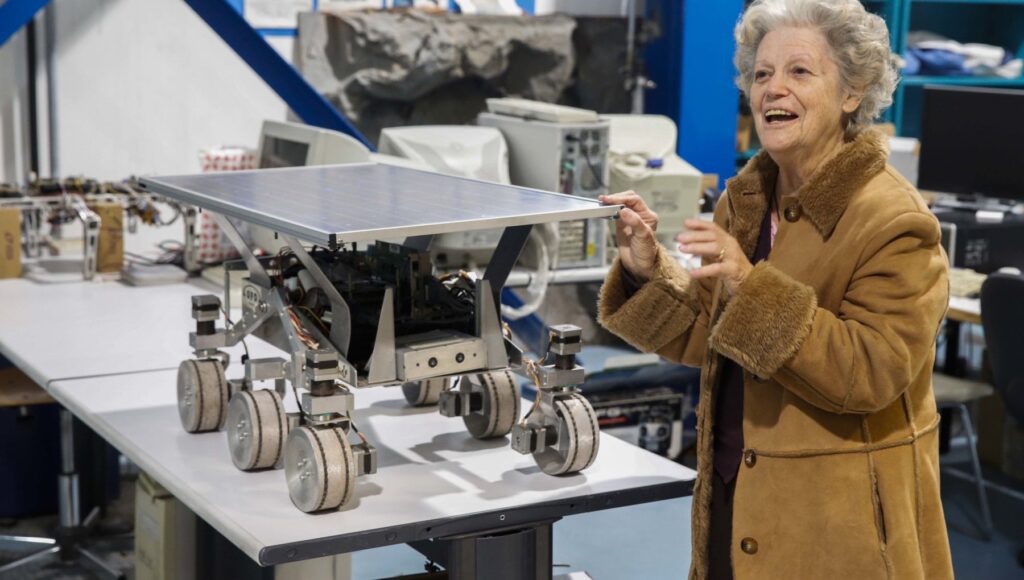
I am heartened to know that if we were on a collision course with an asteroid we would not have to send Bruce Willis onto it, but I don't know if I should tell the Professor. Instead, I ask her what the fundamental components for a mission in space are. "First the ideas, second the people who bring the ideas to life, third the money. That is: the pure contribution of the brain, the contribution of human capacity and then the money to put everything into practice. And I confess that on the economic question I envy the Chinese a little, who decide one thing and do it. We are doing well in Europe, we are good, but we are a little bit quarrelsome and a little nationalist. I believe in Europe, I have always believed in it, also because I was there when the Treaties of Rome were signed. I recently told the European Community that we scientists had thought of a Europe of collaboration, a Europe in which the strongest nation helps the others. That was the concept:the dissemination of knowledge based on collaboration. There is no way like working together to teach others and learn ourselves. Because you learn a lot even from ignorance. Now in Europe things are not quite like that".
Learning from ignorance? "You wouldn’t believe how many things I have learned from the mistakes of my students! Thanks to them, I saw sides of the same topic that I had never tackled from that perspective brought to light. I always say that, there are two cases behind a great invention: either you know everything, and therefore you get there because you have this deep-rooted knowledge, or you don't know anything about it and you throw yourself into it".
So, are we going to Mars? It's a bit of a forbidden dream, right? “Yes. More than half of the missions to Mars, two thirds I believe, have failed. Mars is difficult to reach (so much so that, when they reach it, then they remain there), but it is the only possibility we have to explore a planet where there has been life and where we could bring life back. It can be done.
This article was published in MAP , the magazine of the Alumni of the Politecnico di Milano. Browse through the magazine and discover what’s inside and, if you want, support us.
Credits header: corriere.it
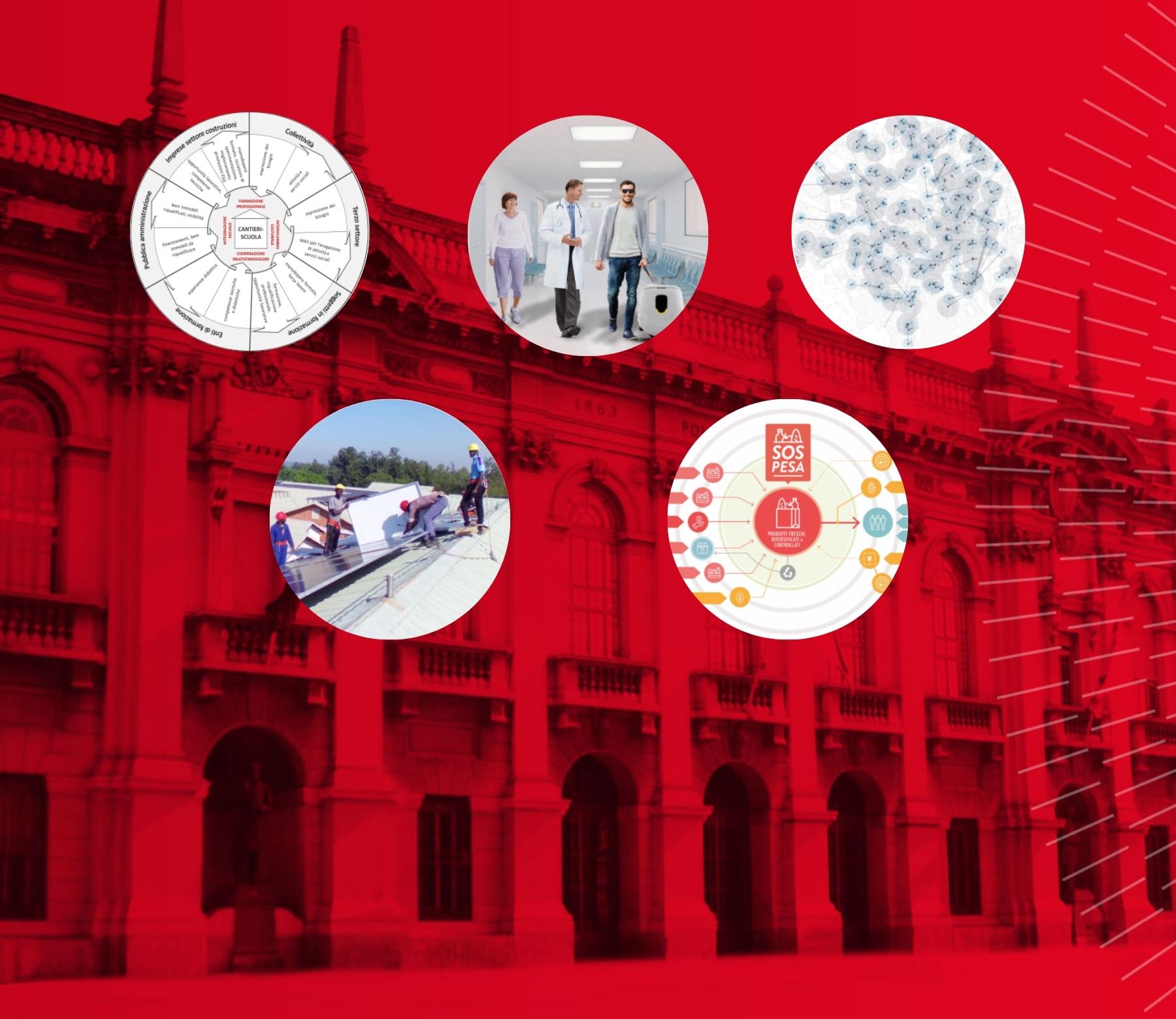
Polisocial Award 2021: launche of the projects funded by the "5 per mille" donations
The five projects selected by the Polisocial Award 2021will be launched in the coming months,on the theme“Equità e Ripresa”. The health emergency has exacerbated social imbalances and exclusion and rendered the increase in inequality a concrete possibility. The funded projects will act from a perspective of economic, social and cultural recovery, promoting the development of methods, strategies, tools and technologies aimed at reducing inequalities and facilitating access to resources and opportunities by particularly vulnerable people, social groups or communities.
SOSpesa: neighbourhood networks for the recovery, distribution and recycling of food surplus
Departments: DESIGN, DIG, DEIB
Tag: recupero alimentare, contrasto alla povertà, reti di quartiere
Location: NoLo district, Milan
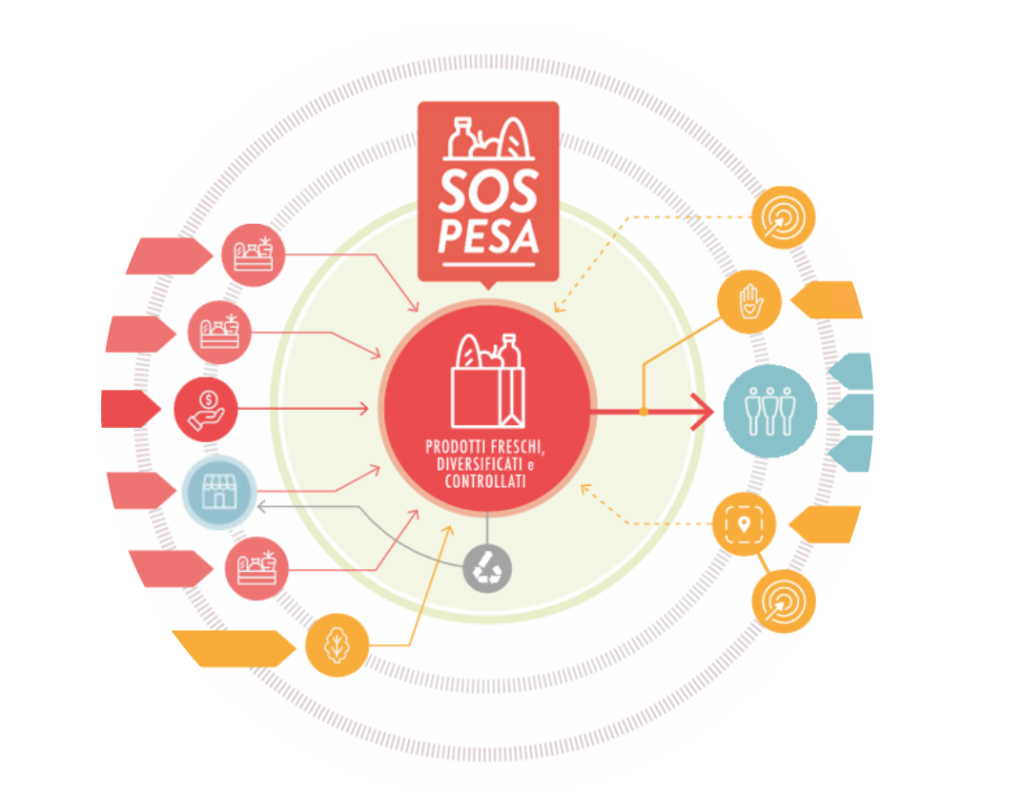
In agreement with the association fabric of the NoLo district in Milan, the project aims to create a network of supportive local actors who, by mapping food flows, will offer food products at regulated prices, recover surplus food and transform unsold goods to help vulnerable groups.
RESTARTHealth: Renewable Energy Systems To Activate Recovery Through the Health sector
Departments: DENG, DIG, DMEC
Tag: efficienza energetica, sanità, Africa
Location: Gulu District, Uganda
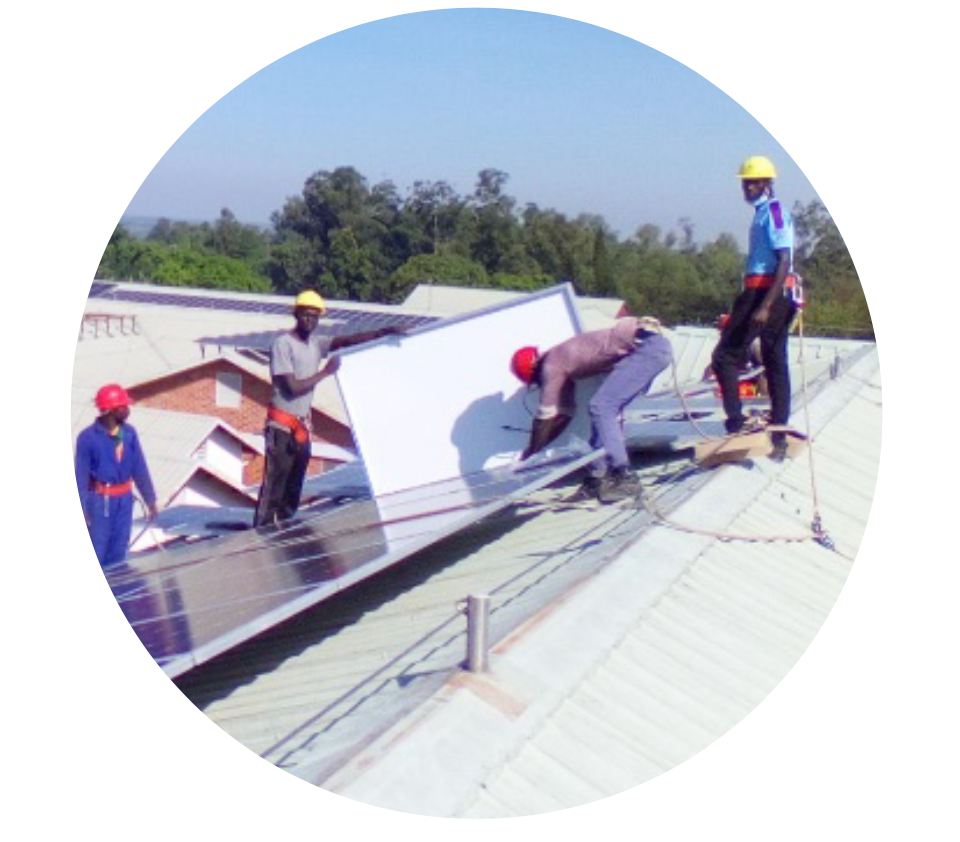
The project aims to strengthen the health and community services infrastructures in sub-Saharan Africa by studying efficient electricity management for hybrid micro-grids. Tests and demo applications in a hospital and three health centres in Uganda will produce general guidelines.
EQUI_06: equity and quality for children. Guidelines for implementing the integrated system 0-6 years
Departments: DASTU, DIG, DESIGN
Tag: servizi pre-scolari, educazione, quartieri marginali
Location: Milan
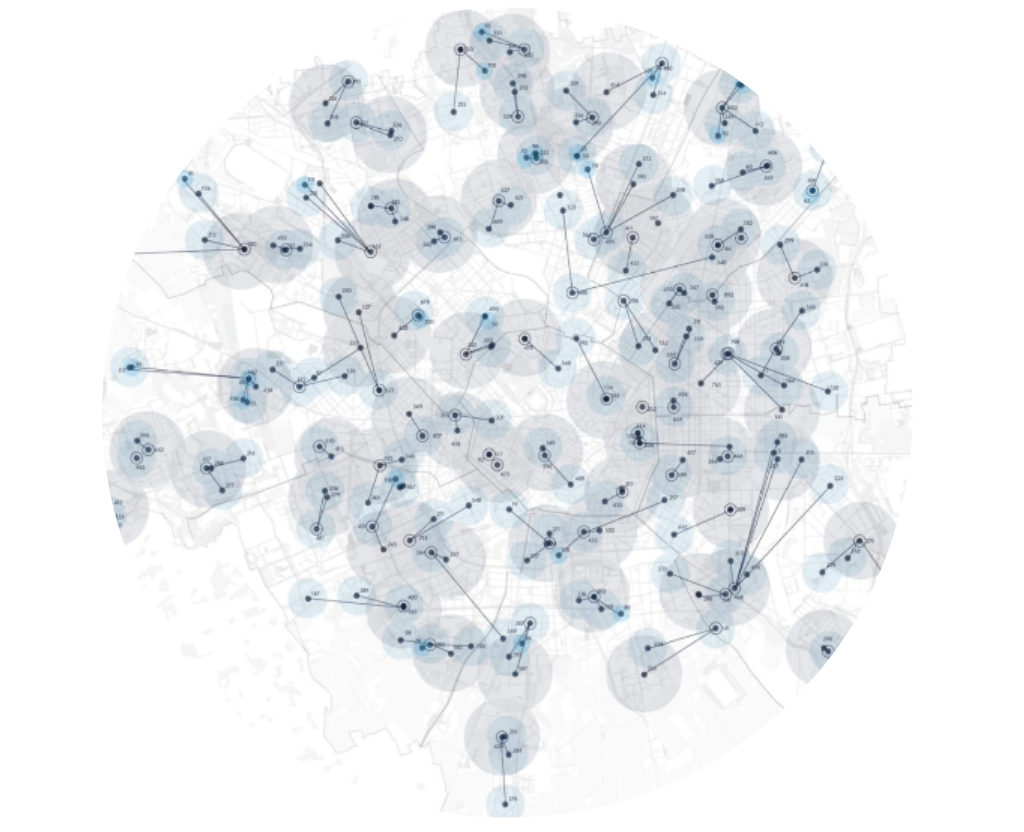
Starting from a pilot study, which will help to explore the complex framework of needs and resources relating to early childhood, the research seeks to define guidelines for the creation of integrated territorial hubs of “0-6” pre-school services. The focus is on urban areas, in particular the areas at greatest risk of social exclusion and educational poverty.
coWIN: win-win cooperation building sites for the redevelopment of properties seized from the mafia
Departments: DABC, DASTU, DIG
Tag: legalità, occupazione, recupero immobili
Location: Lombardy/Milan metropolitan area
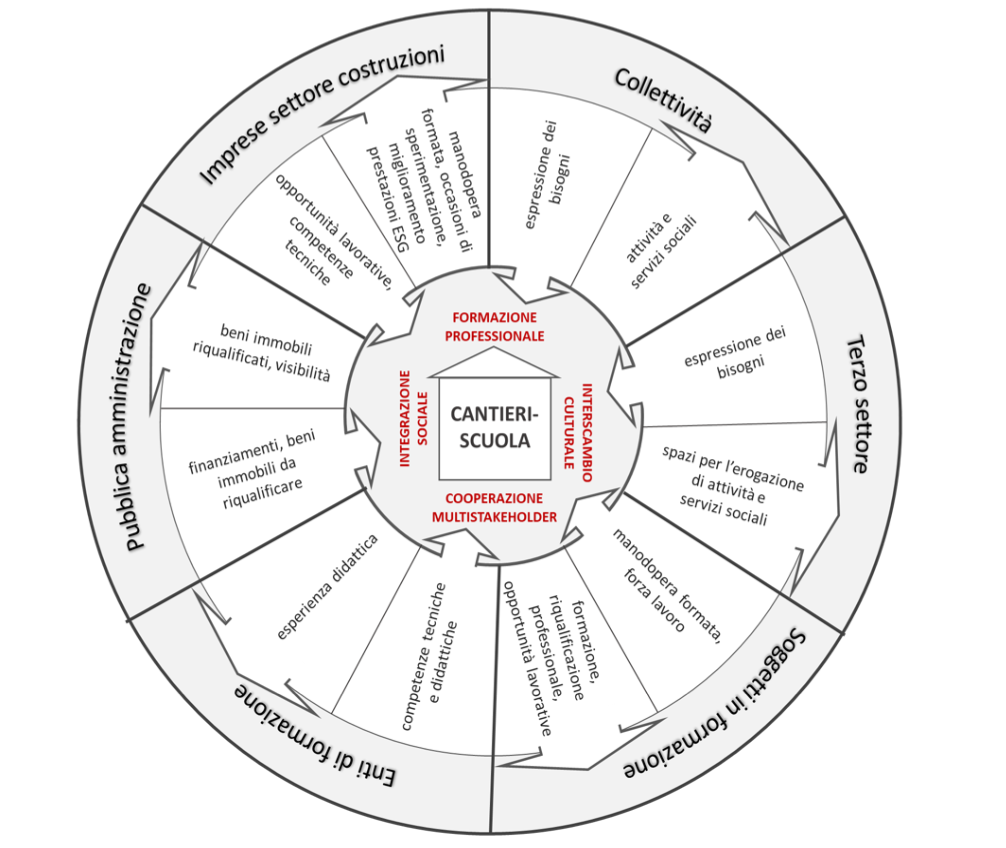
Pilot experiments for the development of an innovative “hub and spoke” model for the recovery and redevelopment of properties seized from members of organised crime. The aim is to spark social regeneration based on the technical training and employment integration of vulnerable groups, leaving tangible signs of equity and legality.
Budd-e: Blind-assistive aUtonomous Droid Device
Departments: DEIB, DIG, DESIGN, DABC
Tag: disabilità visiva, accessibilità, robot-assistance
Location: Milan
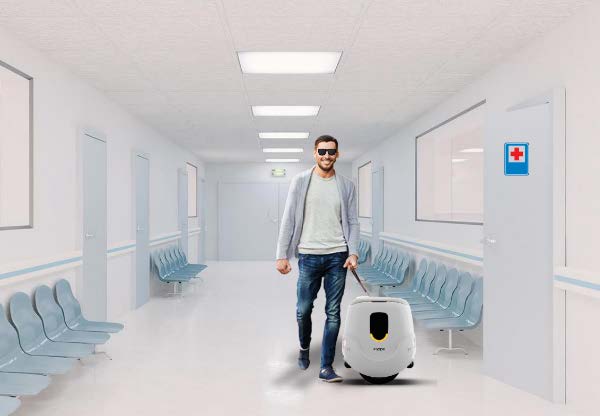
It addresses the needs of visually impaired people affected by the COVID-19 lockdowns and the restrictions imposed on the daily use of spaces and services, and more. How do we make them fully accessible so that visually impaired people can use them independently and safely? The integrated approach involves inclusive design, robotics, Automation and Architecture. The researchers predict a strong impact on wayfinding applications in medical and care facilities, shopping centres, cultural centres (e.g. museums) and sports centres. In particular, the E4sport laboratory will support the the implementation of the Budd-e project in the Giuriati sports centre to help blind and partially-sighted users during sports activities, such as running.
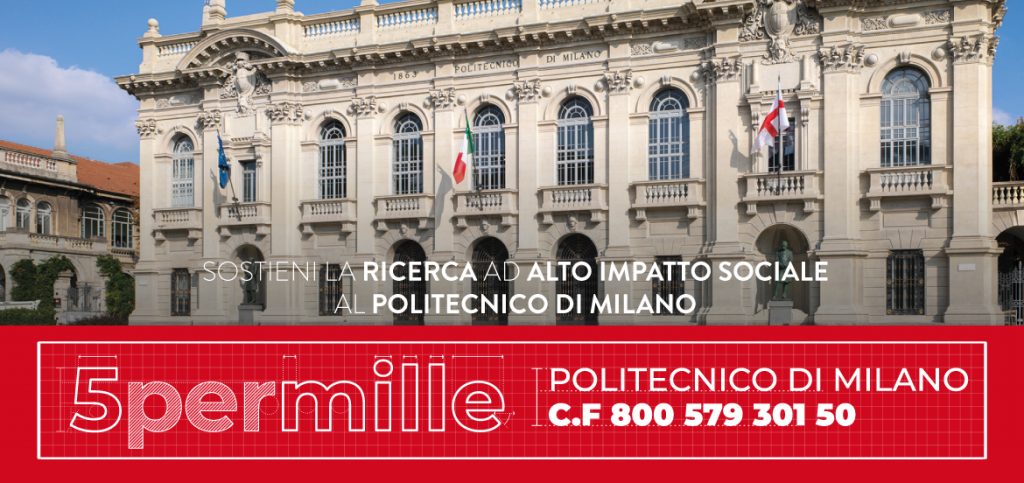
Credits images: http://www.polisocial.polimi.it/it/home/
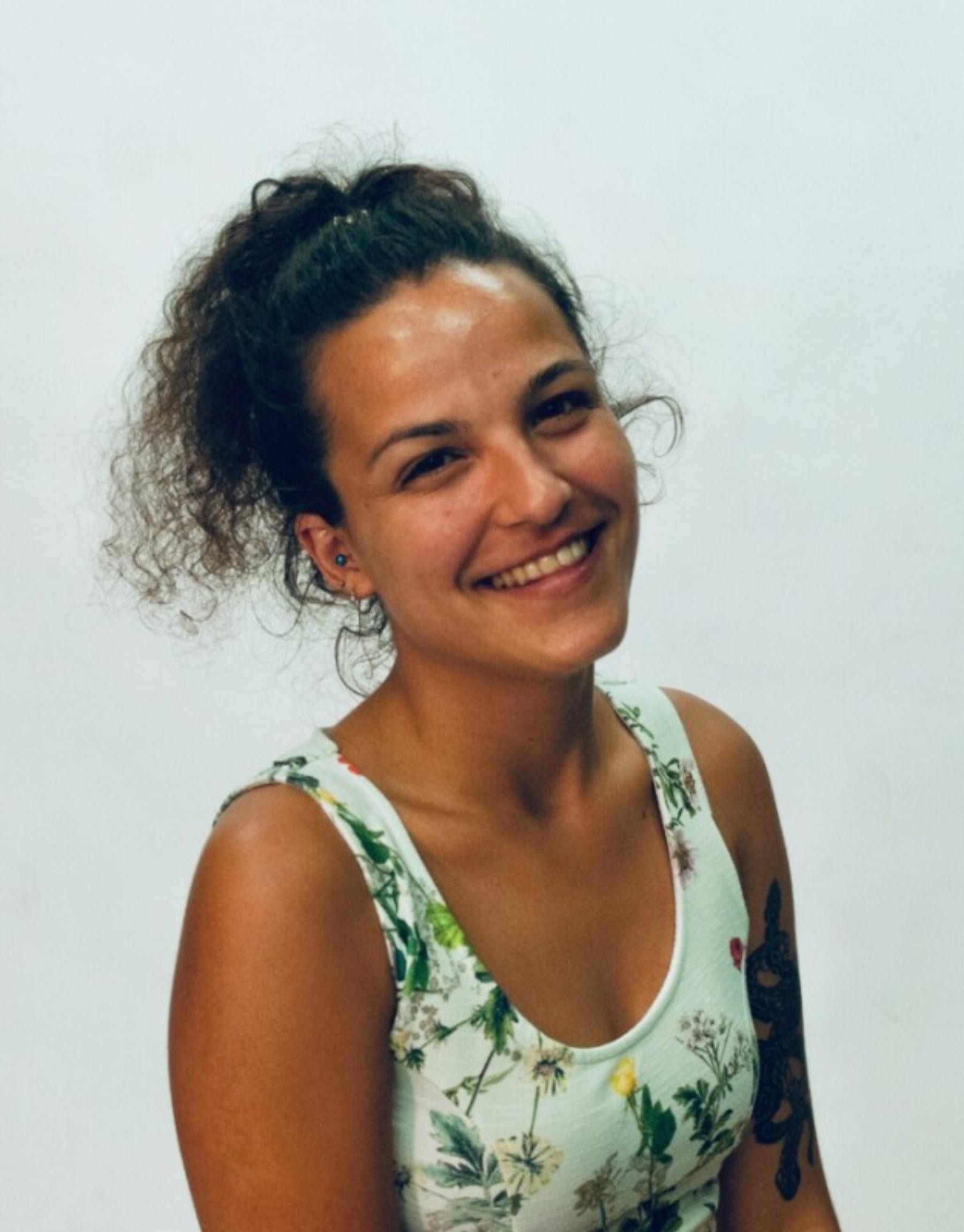
Healthcare and Design: the Politecnico presents Eolo
In the 13th edition of Switch2Product at Switch2Product new technologies and business ideas include Eolo, by the design researcher and Alumna Aurélie Glaser.
The project also received the €30,000 grant awarded by the Chamber of Commerce of Milan, Monza, Brianza and Lodi for the solution with the greatest potential for generating a positive impact on the local economic system.
But what does Eolo do? And what is its innovative feature? We asked Aurélie herself:
Eolo is a supportive respiratory muscle training device, whose goal is to improve the respiratory capacity of its users, proposing a new, more inclusive, supportive and systemic model of medical care.
“More than just a medical device”, adds Aurélie, “our project aims to improve the quality of life of millions of people by empowering them and raising awareness of the importance of respiratory health.”
More specifically, Eolo is a portable handheld device for remote care that assesses and improves the respiratory capacity of its users with simple inspiratory and expiratory exercises and testsBased on the principles of RMT (Respiratory Muscle Training), Eolo focuses on training various muscles essential to respiratory function, such as the diaphragm, external and internal intercostal muscles and other accessory muscles, in terms of endurance, strength and flow.
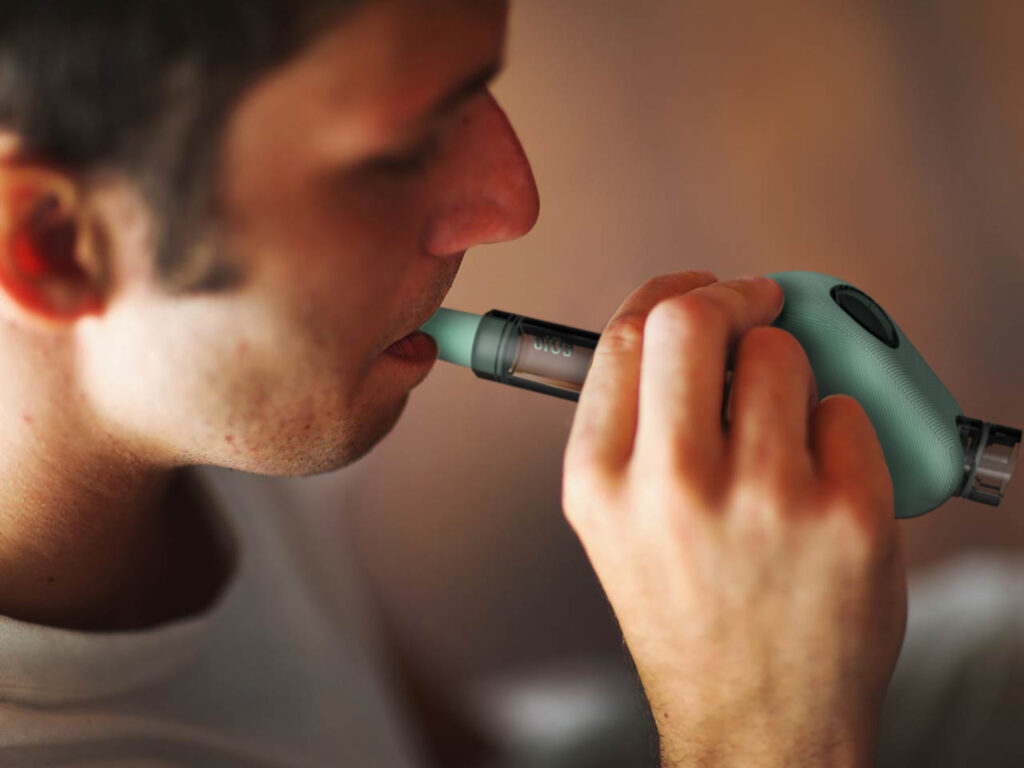
Nowadays, respiratory health and respiratory diseases - especially since COVID-19 - are a global priorityin this context, Eolo serves as a potential integrated and versatile resource in the health, sport and wellness sector.
It is therefore mainly intended for patients with conditions that compromise their respiratory capacity and therefore positions itself in the e-health and medical device markets. It is also perfect for the physical performance and sports device markets as it is beneficial for professional athletes and amateur sports enthusiasts. Finally, the fact that it teaches good breathing techniques and helps to improve the respiratory strength and stamina makes the device also suitable for the wellness market.
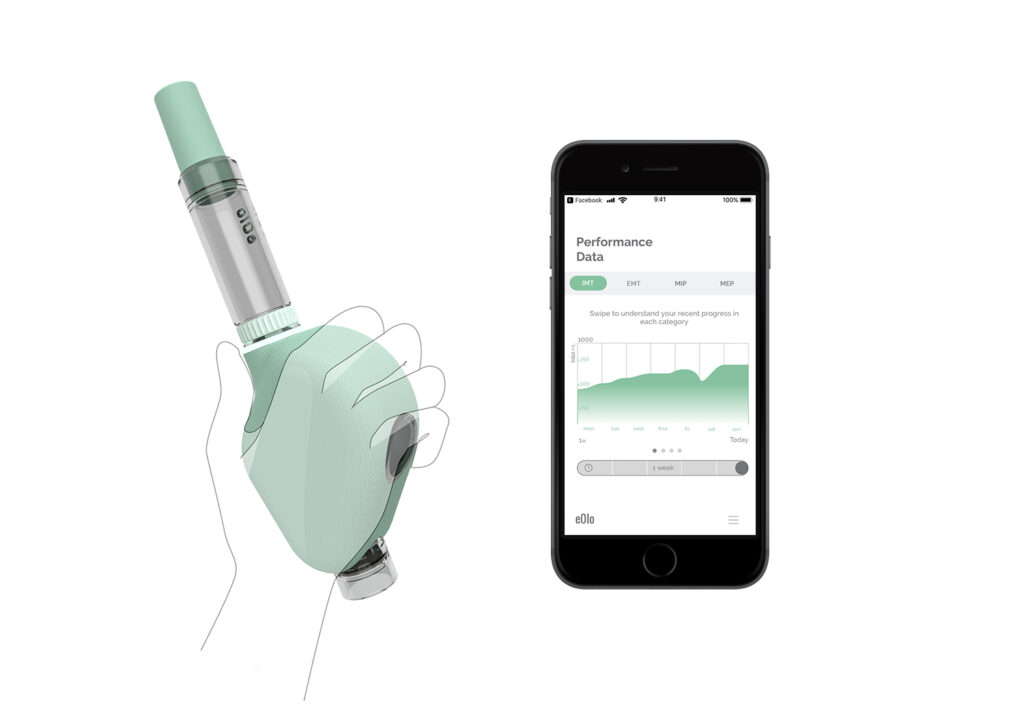
We asked Aurélie why she decided to focus her research on this topic:
“I have always been very passionate about the healthcare field and the numerous unmet needs users and patients encounter. I believe design can bridge a gap between users and the medical community by raising awareness, empowering people, and improving their quality of life. I strongly believe research and design could be key elements to provide solutions to such matters by following the four Ps (predictive, preventive, personalised, participative) model of clinical medicine and addressing numerous current challenges our society faces”.
EOLO AND THE FUTURE
The next steps of the project within the acceleration programme will help Aurélie and her team to define more clearly the target market, the needs of potential users, validate the previous research carried out and create the business model. Meanwhile, the development of the device continues and the grant will be used to create a prototype.
All this has been achieved at the Politecnico!So, we asked Aurélie why she decided to move to Italy from France to study here.
“After following my bachelor's degree in France, I wanted to explore and apprehend new cultures of design and life. Such experience is fundamental and enriching as it increases your knowledge and opens your mind. Milan offers a very stimulating setting with a rich design background and know-how. Politecnico is a renowned university that proposes a rich, technical and multi-disciplinary educative approach in line with my values and aspirations to grow as a researcher, designer and person.”


The Milan of tomorrow: a gallery of Politecnico works
“Milano: quartiere che vai, Alumni che trovi” (Milan: Alumni in every neighbourhood). No, we haven’t gone mad: we just read this article by Urban File, which announces the winners of the second edition of the ‘Architecture and Urban Planning Award 2021’ for the city of Milan and we discovered that 7 of the 8 projects are by former Politecnico students. Not bad, eh?
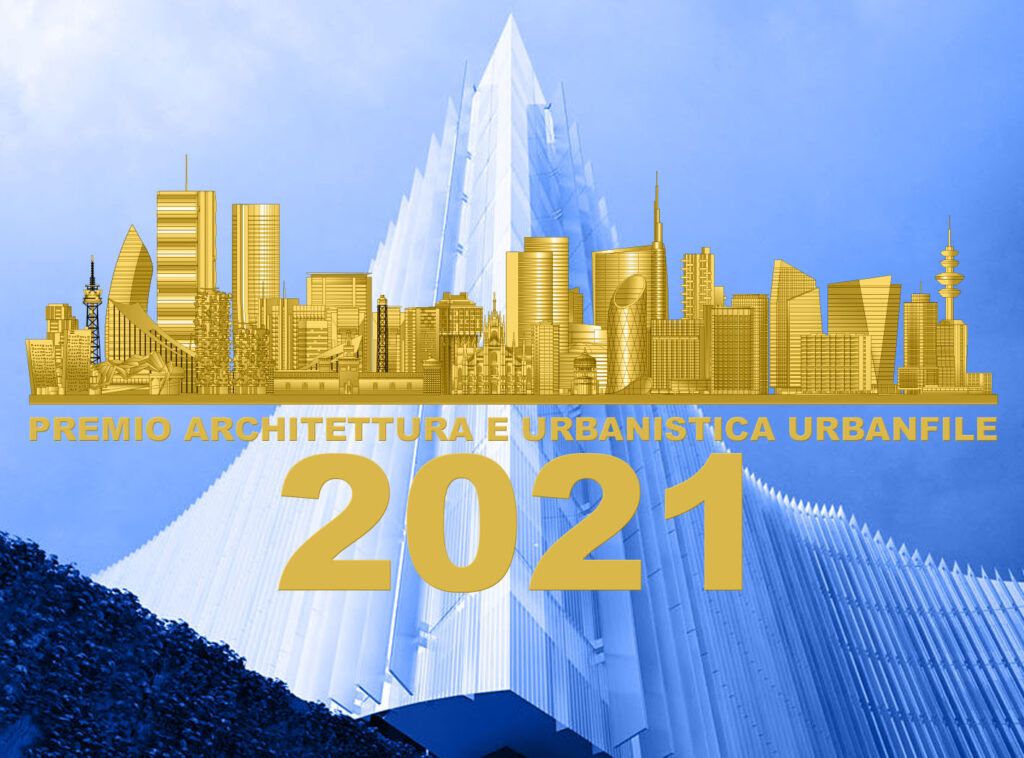
Let's take a look at them: who knows, you’ve probably walked right past some of these without realising...
CITTÀ STUDI – NEW LEONARDO CAMPUS | RENZO PIANO AND OTTAVIO DI BLASI
Urban Furniture – Public spaces – Cycle paths – Green
Our new Campus, inaugurated last June, wins in the category ‘Urban Furniture – Public Spaces – Cycle Paths – Green’.
The redevelopment of the architecture campus at the Politecnico is a project that comes from afar and that we start talking about in the spring of 2017 (the beginning of the story can be found on MAP #1) thanks to the idea donated by Renzo Piano to the Politecnico, later designed by another great Alumnus, Ottavio Di Blasi – ODB & Partners (his interview on MAP #7).
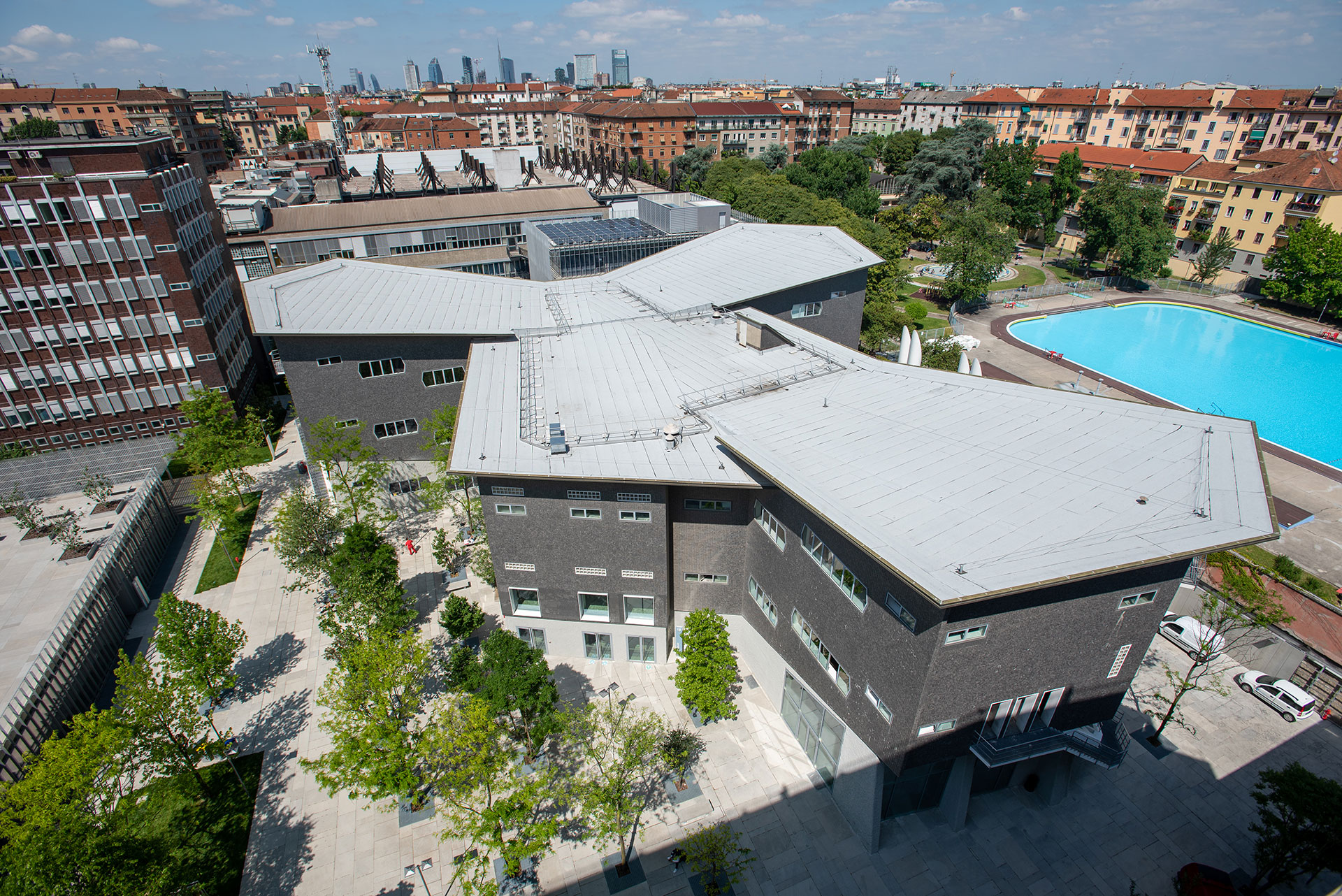
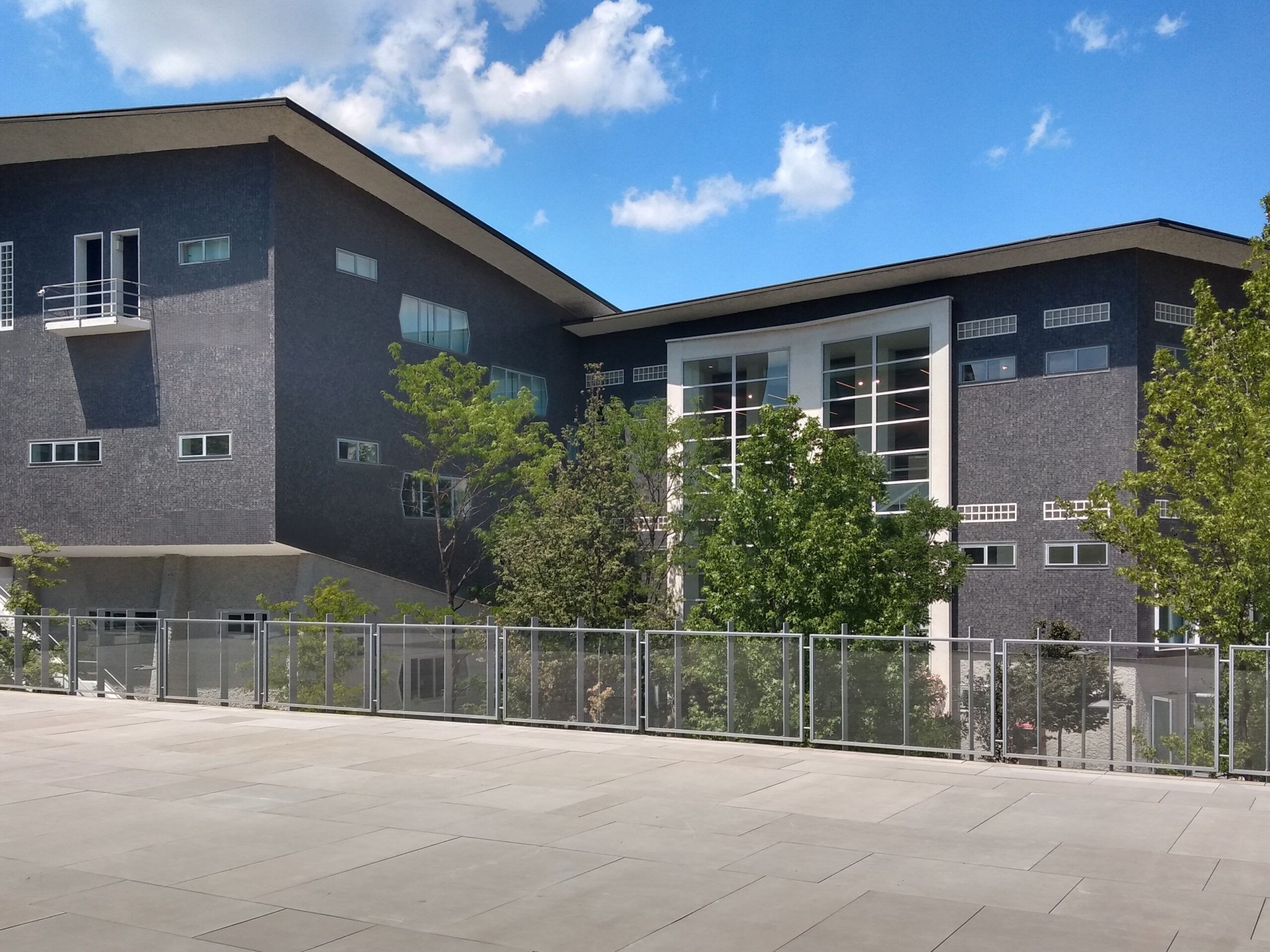
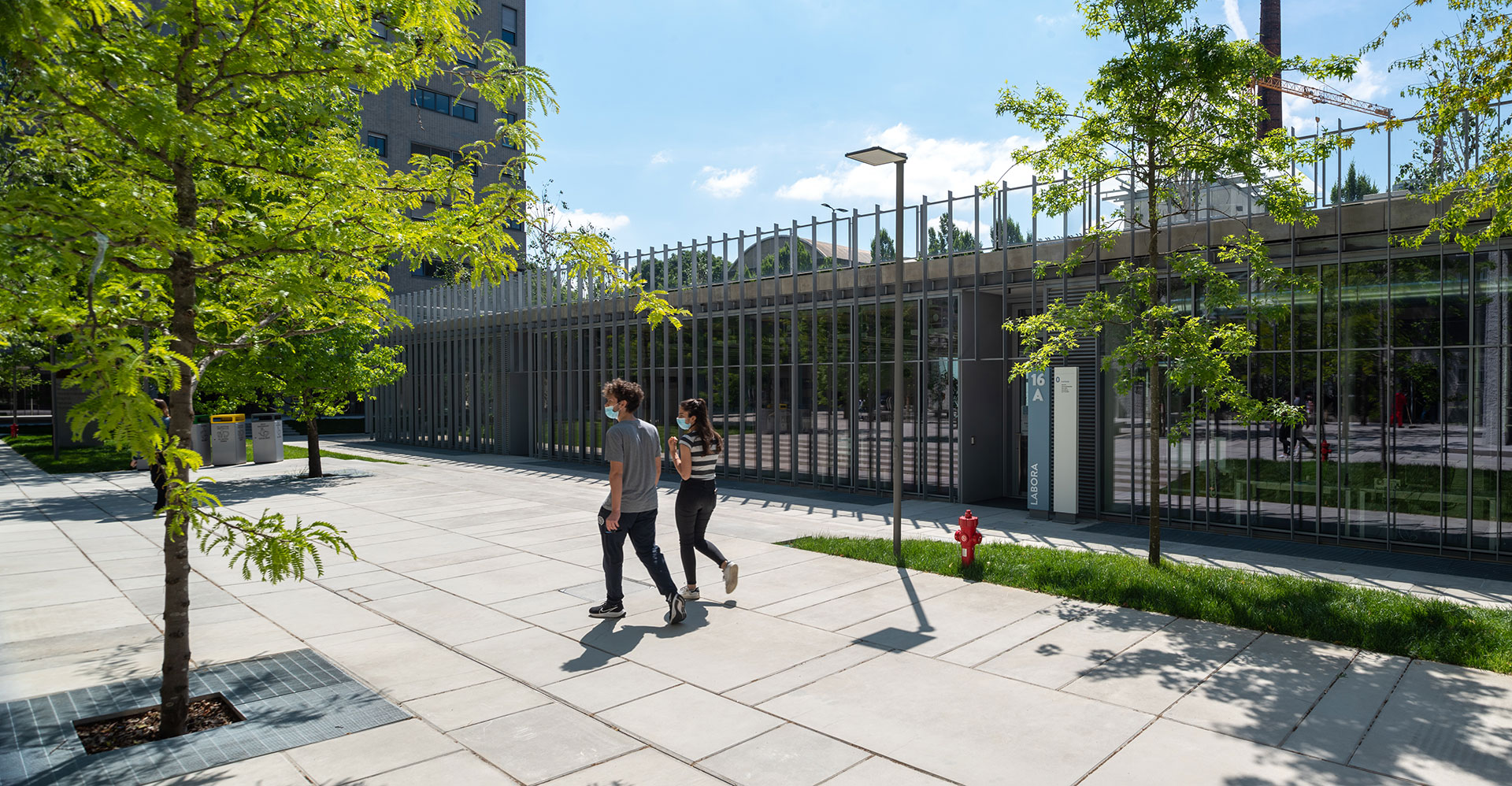
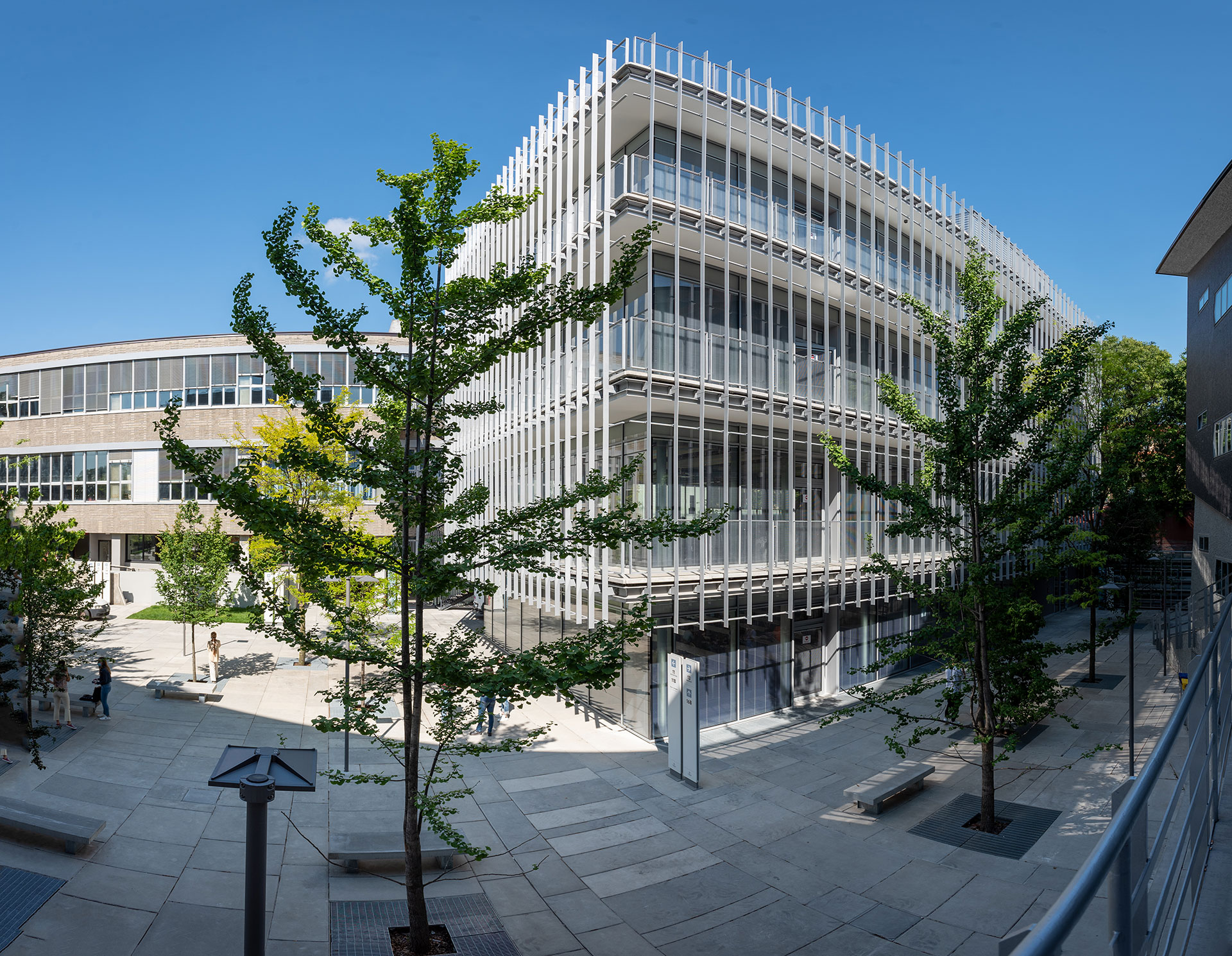
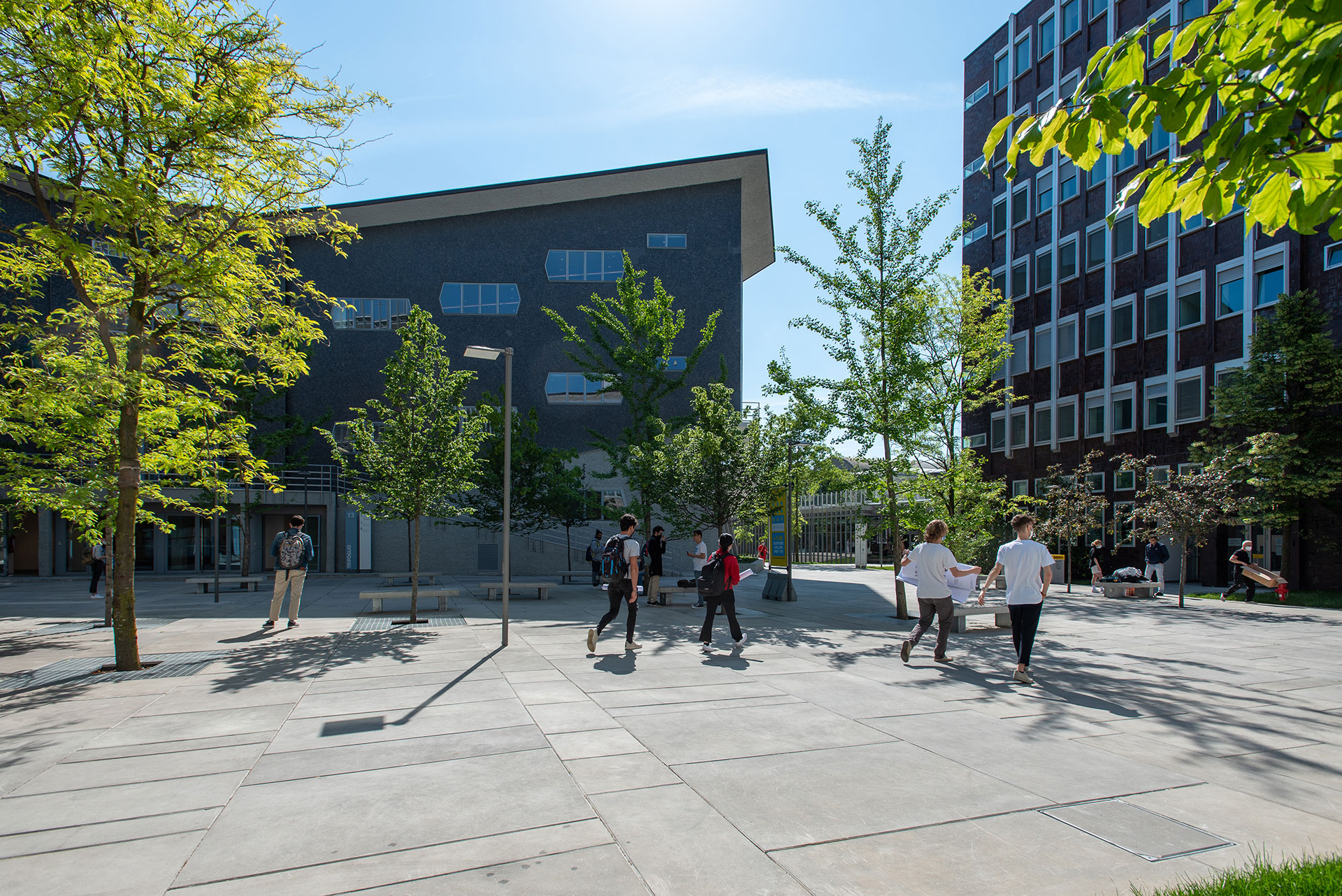
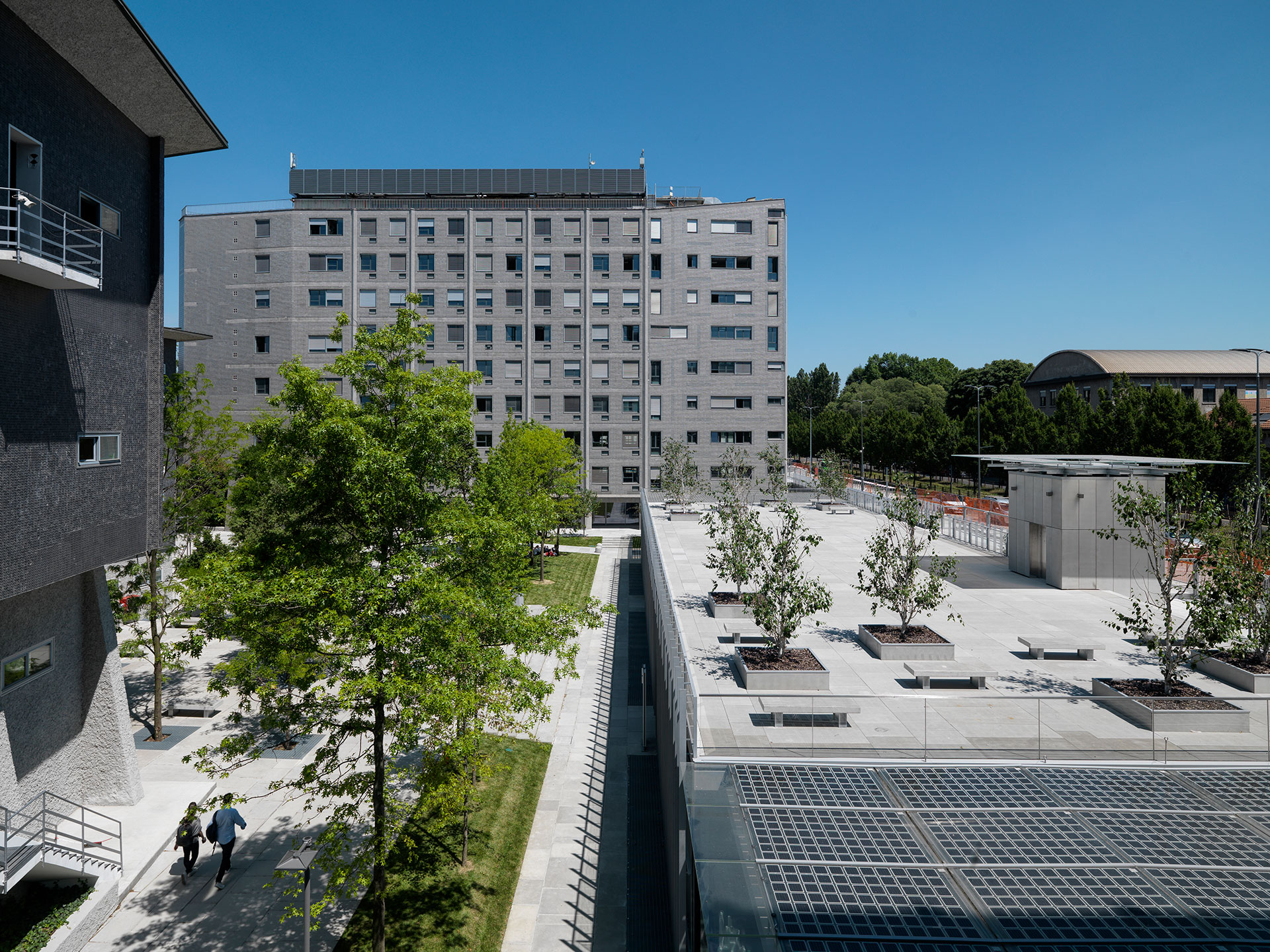
The two architects conceived and developed a radical reorganization of the spaces in via Bonardi, based on the philosophy that Piano defines as “mending”: indeed, “mending” and connecting are among the functions of the new Campus, conceived as a space open to the whole city, an urban park that connects Parco Ponzio with the green landscape of Piazza Leonardo da Vinci.
In the words of Urban File:
“The spaces previously used only as a through way and a service, with a lack of identity and barren appearance, have been transformed into a beautiful, liveable and above all green place.”
To find out more, read the news: Inaguration of the new Campus in the presence of the President of the Republic
ISOLA – ALSERIO 10 | ASTI ARCHITETTI
Redevelopment of existing buildings: residential and hospitality
The Asti Architetti (architect firm owned by Alumnus Paolo Asti) in via Alserio 10 transformed the location into a sophisticated residential building renamed “Isola 10”.
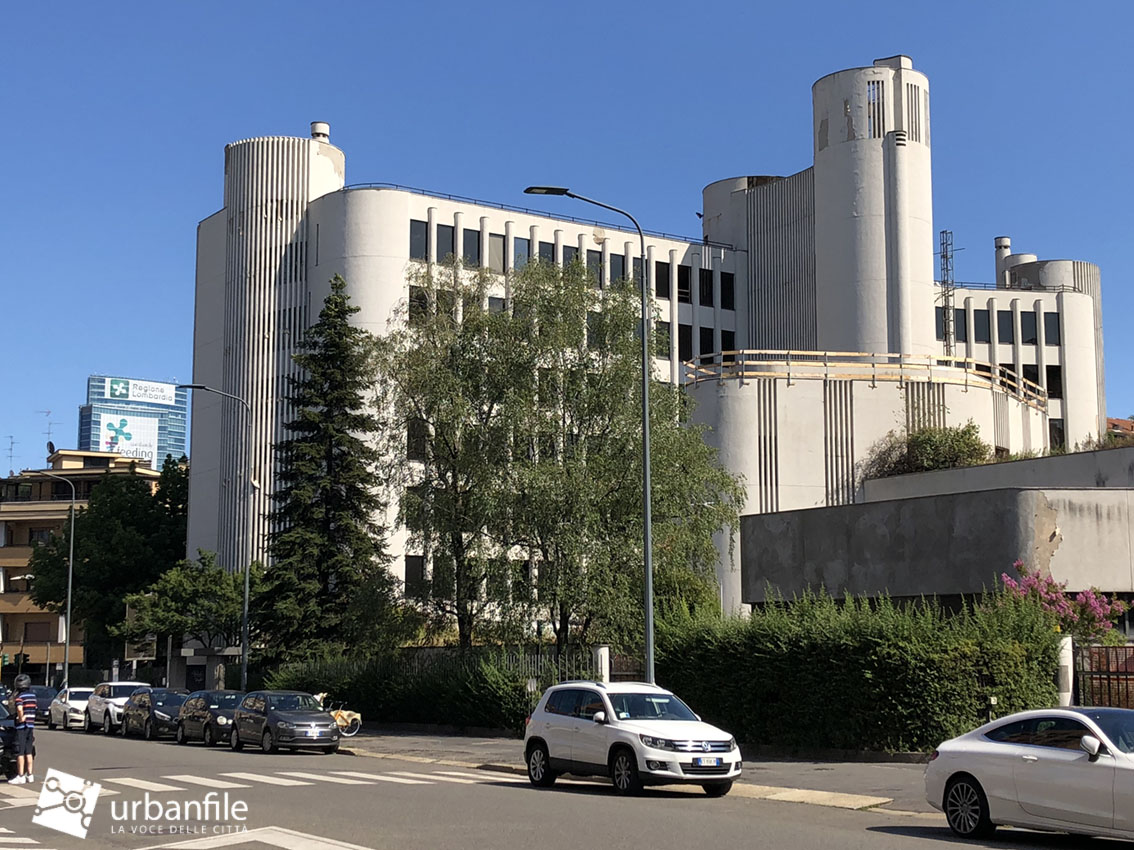
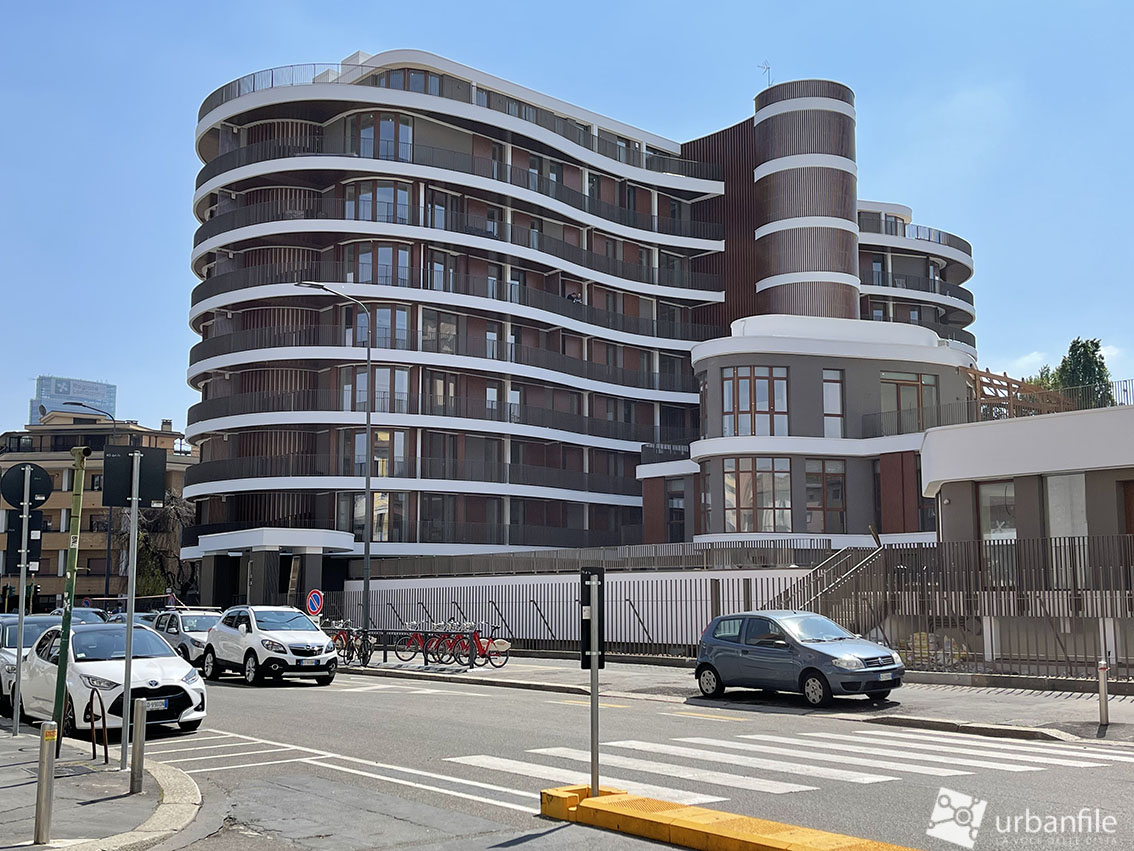
“The sinuous curves of the large balconies designed by Asti Architetti, the synthetic wood cladding, have given a much more sophisticated image to this unusually shaped building, originally built [in 1970] as the headquarters of the Reader's Digest.”
PORTA TICINESE – VETRA BUILDING | STUDIO IL PRISMA
Redevelopment of existing office buildings
In terms of the redevelopment of existing office buildings, Urban File believes that the most interesting project carried out in 2021 is the Vetra Building, , in Piazza Vetra 17.
The building was originally built in the early 1960s designed by Ferdinando Reggiori to create a new headquarters for the Milan Tax Service in a neighbourhood that was set to be resurrected following the devastation of the Second World War. Over time, however, the area became increasingly degraded, until the park was fenced off in the 1990s to allow it to be closed during the hours in which there was no guaranteed surveillance, while the entire area in front of the building next to the park became a dodgy place of petty crime.
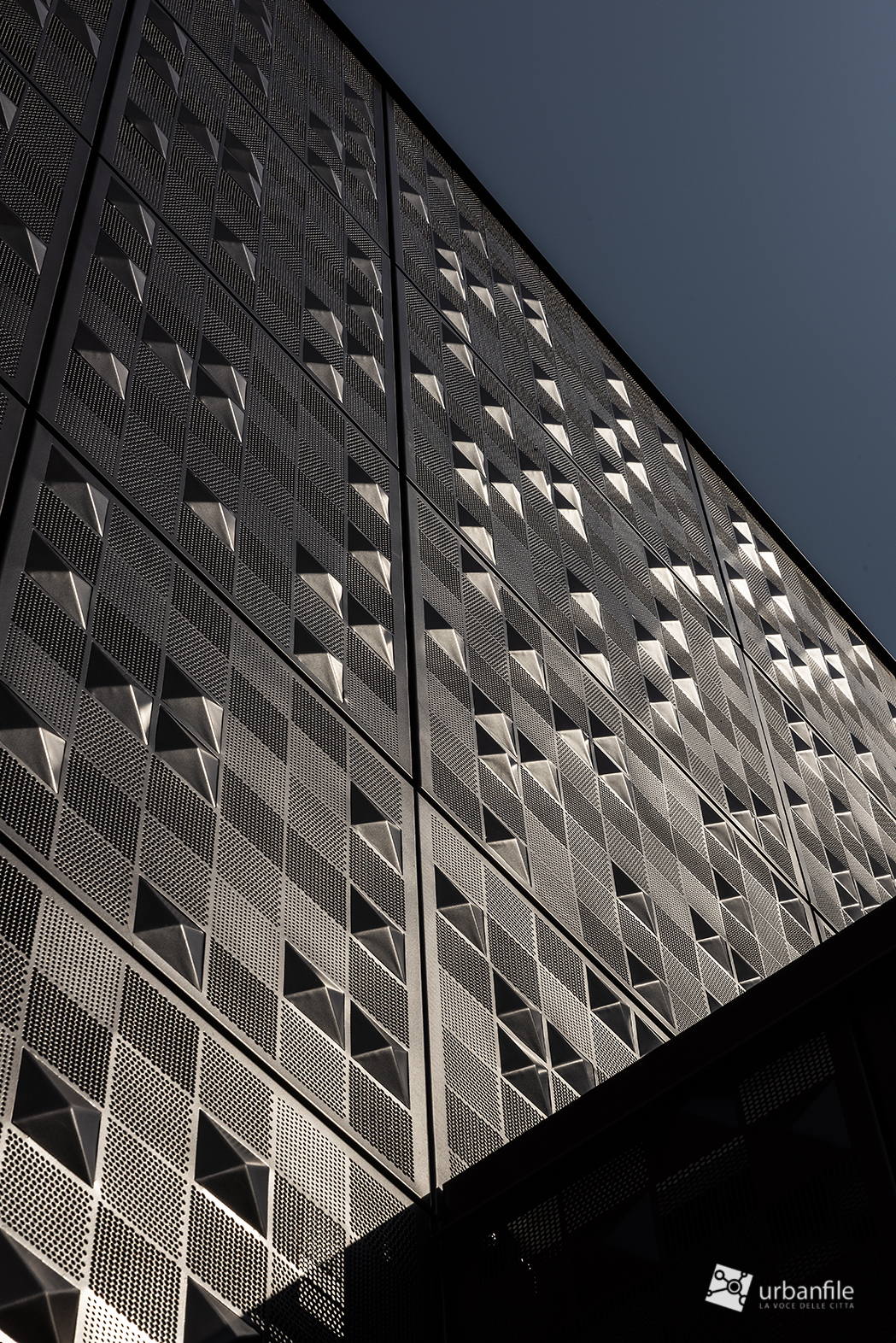
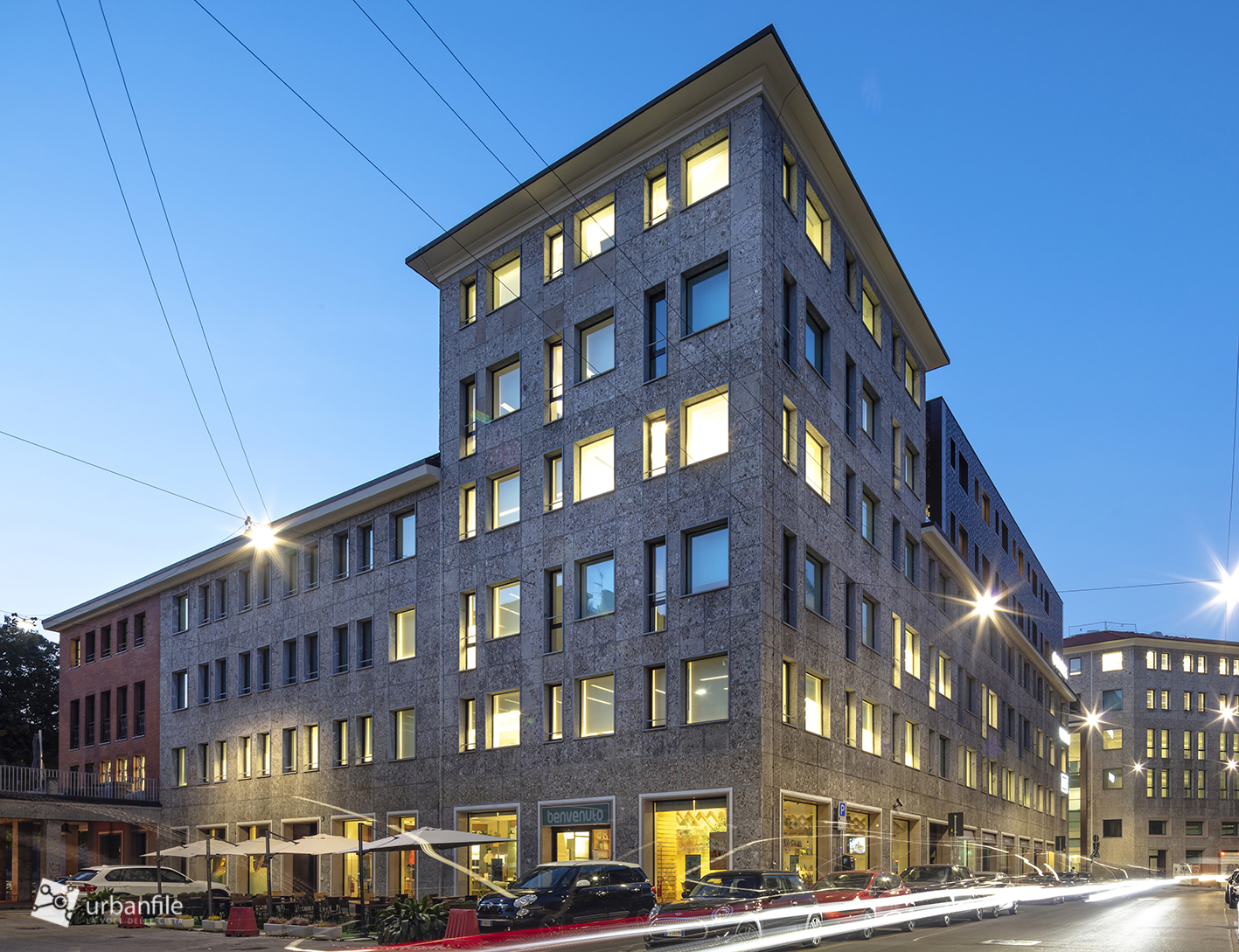
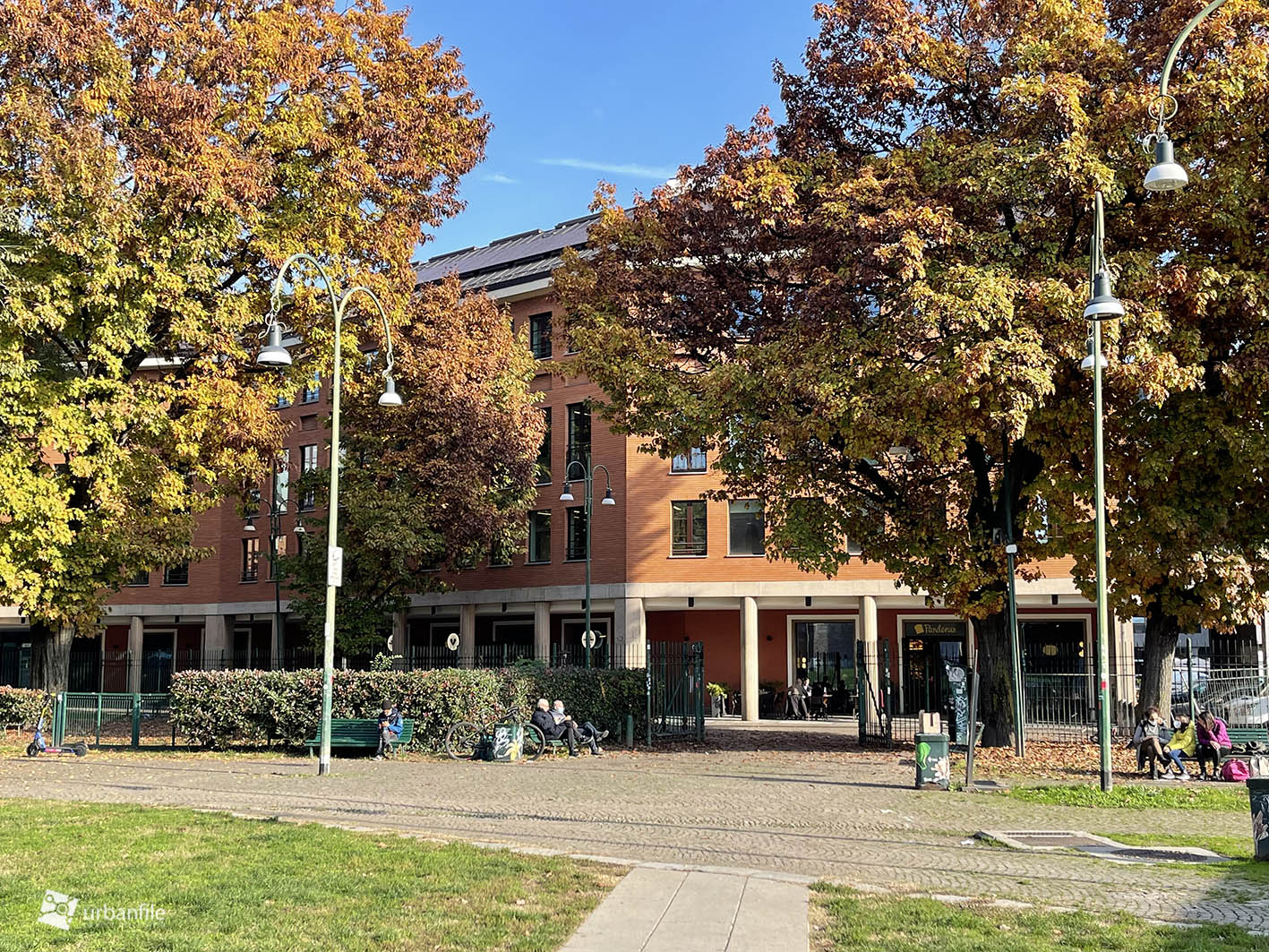
The project by the international architecture and design company Il Prisma and Artelia – whose leading partners include the Alumnus and construction engineer Carlo Carone – regenerated the public space through the redevelopment of the building, to restore a new dialogue with the city, also through architecture and art, reviving even the arcades abandoned to their fate in the past, opening up a passage through the middle that unites two sides of the neighbourhood, including a spectacular work of art by Patrick Tuttofuoco."
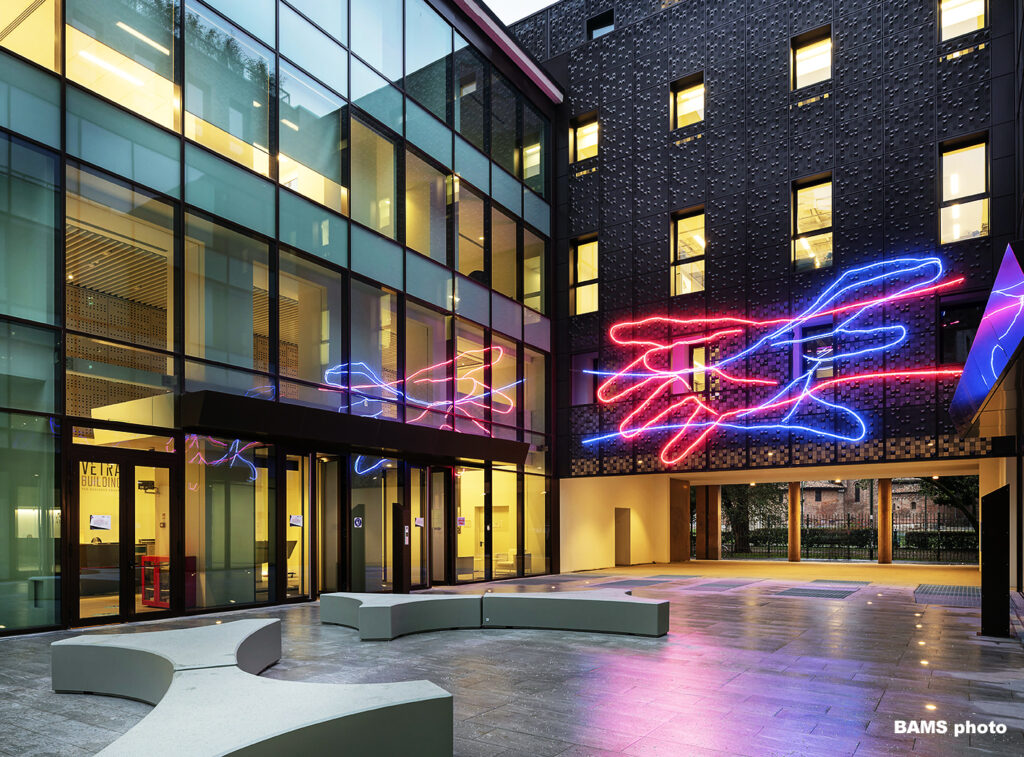
FIERA – CASA BORIO | CALZONI ARCHITETTI
New residential building
Calzoni Architetti, firm owned by Sonia Calzoni , Alumna and professor at the Politecnico School of Design, designed Casa Borio, a small and elegant building in via Monte Rosa 66.
With a 1960s style and simple and effective lines, the building has large balconies overlooking the small garden to the south, in amber shades that offer warmth and reassurance.
There is an interesting “differentiation of facades: more urban overlooking public streets and more open, with large glass windows, continuous balconies and facades covered with recomposed wood to interact with and belong to the garden below.”
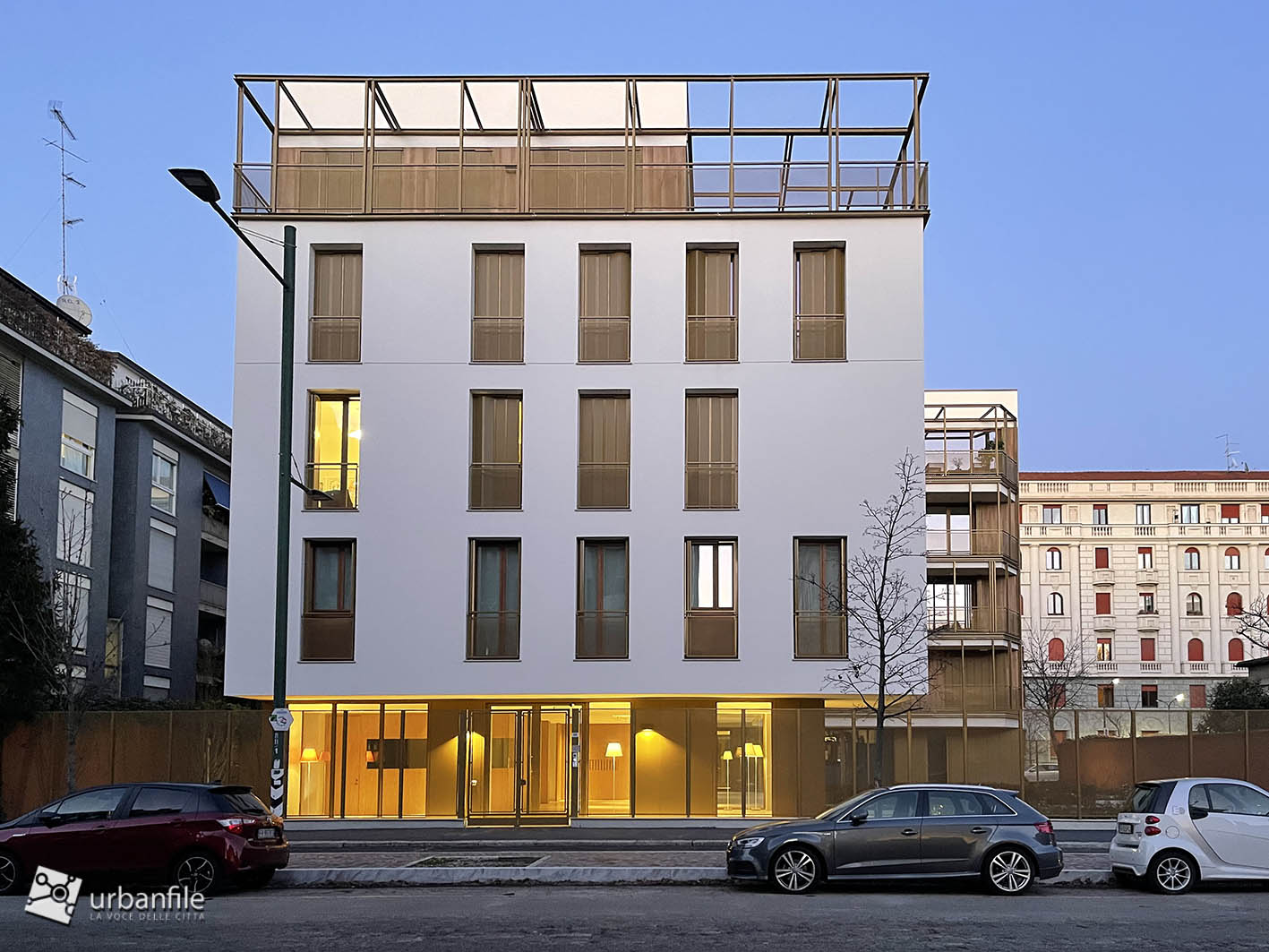
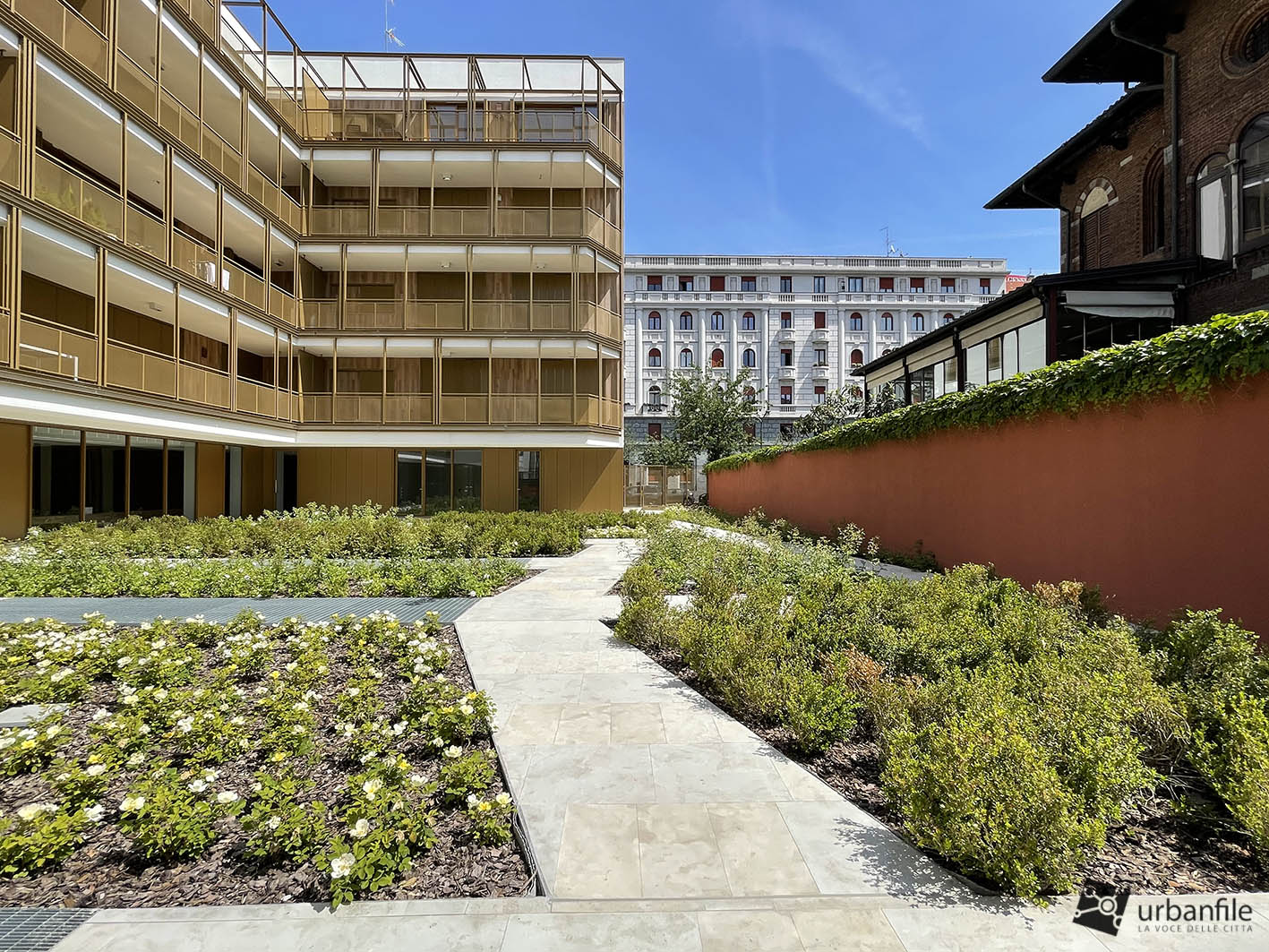
BARONA – THE SIGN | PROGETTO CMR
New office buildings
Progetto CMR led by the Alumnus Massimo Roj designed the office complex “The Sign”, which wins the category ‘New office building’.
This build “ solved and revived an otherwise depressed area of Milan, creating a pleasant working space and a square, Piazza Fernanda Pivano, perfect for taking a stroll and relaxing during work breaks.”
The complex includes two office buildings of 9 and 11 floorsa production building of 3 floors and a large pedestrian and public square covering a total of 20,400 m2.
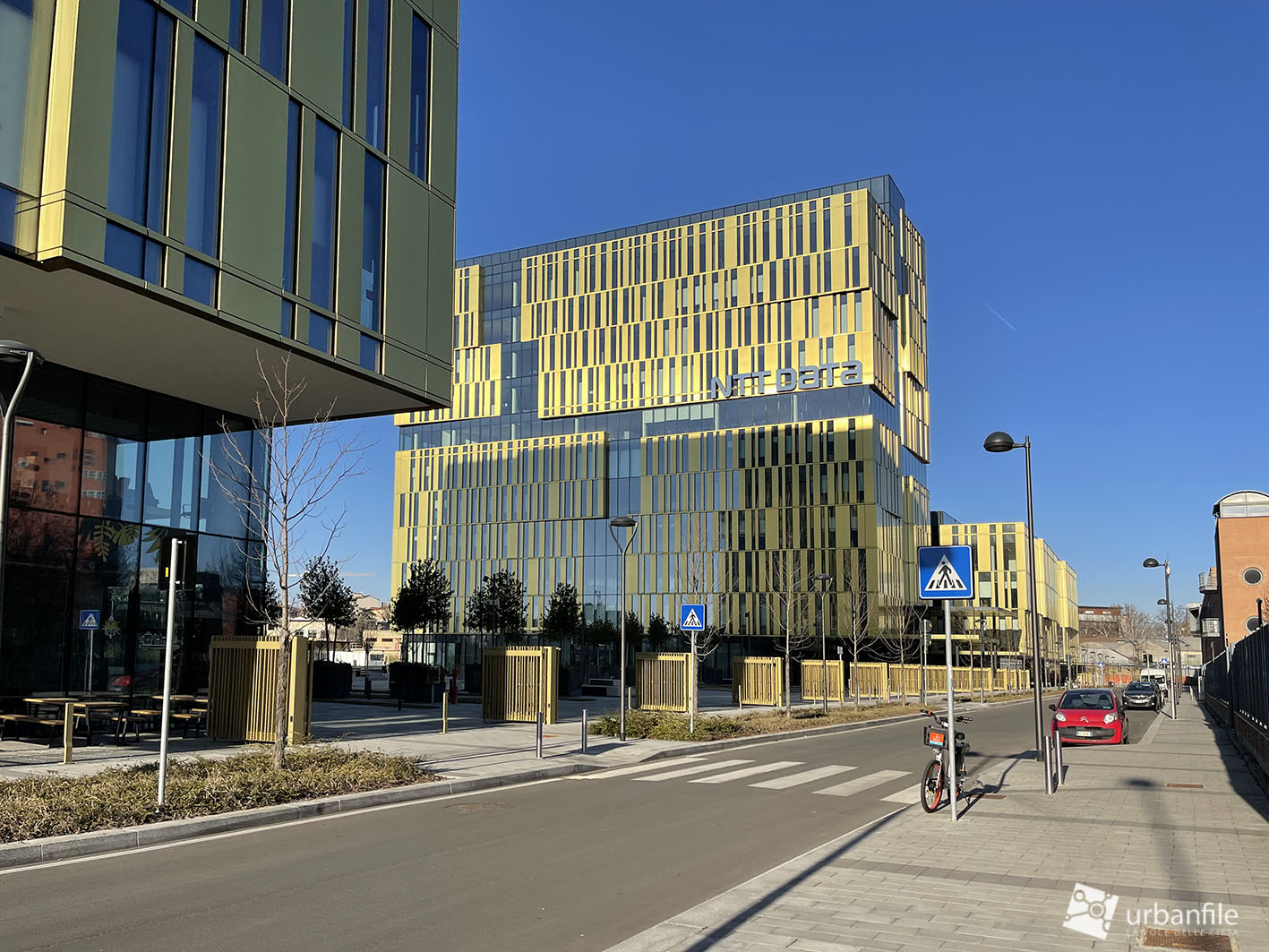
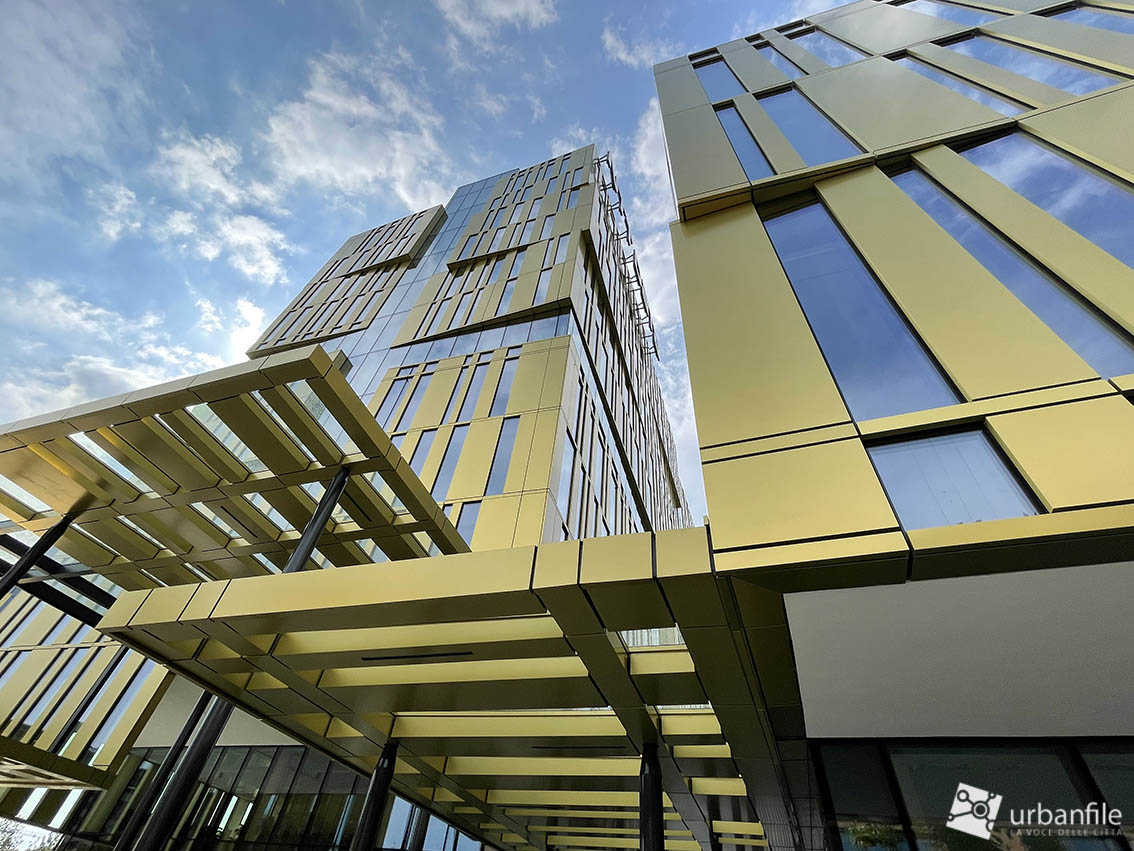
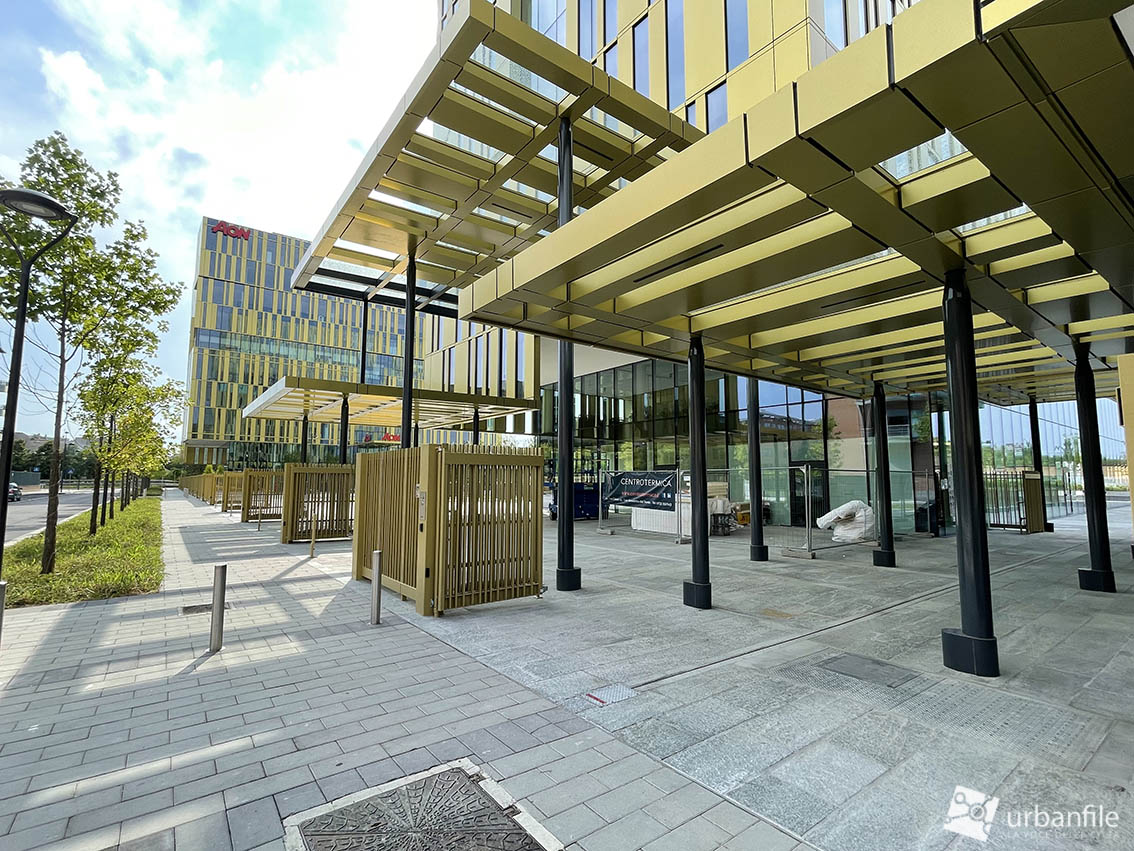
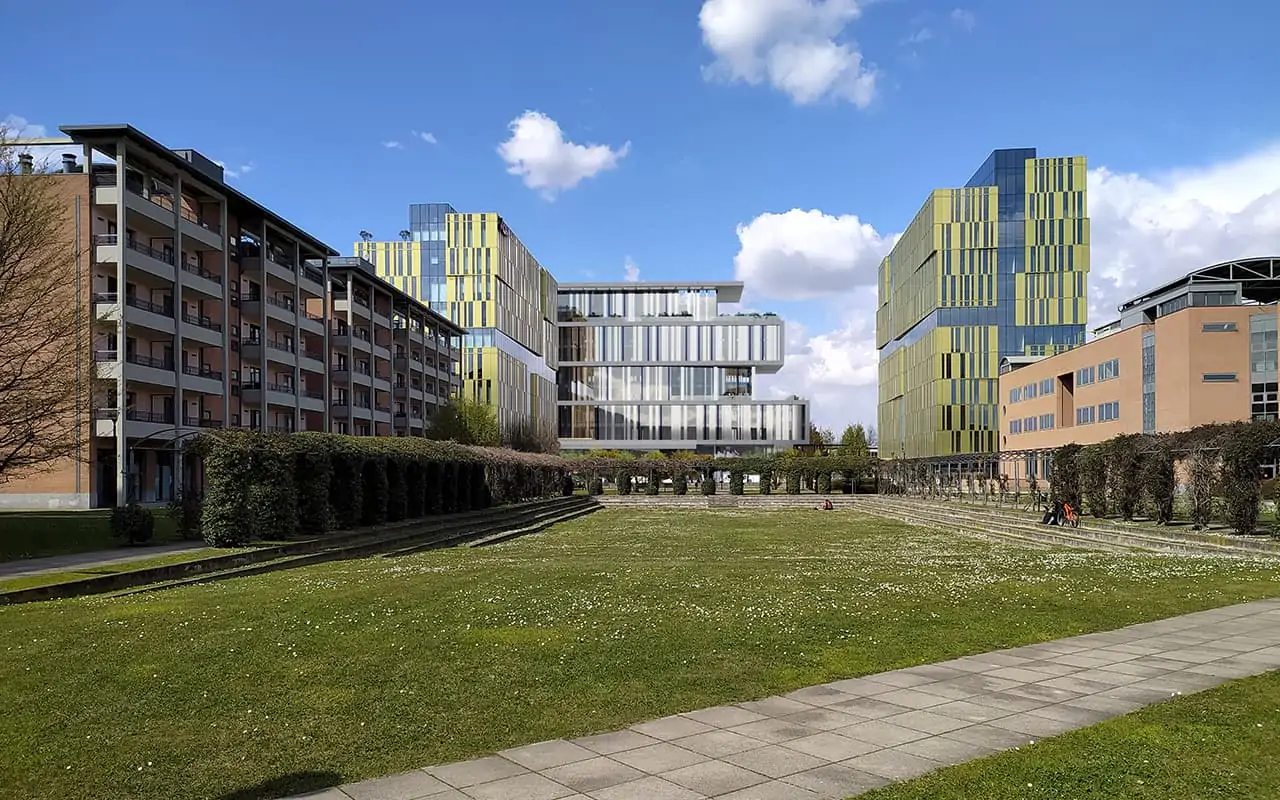
TRENNO – NUOVA PRIMARIA VISCONTINI | TECNICAER ENGINEERING
School and Sports buildings
Behind the new primary school in Via Viscontini in Milan is Tecnicaer Engineering, led by architect and Alumna Margherita Carabillò.
This shared and participatory project engaged teachers, parents, school collaborators and children.
“The school building is state-of-the-art with low environmental impact and high energy efficiency, including photovoltaic panels on the roof. The building was designed to ensure optimal acoustic performance and ensure high-quality natural internal lighting.”
The school complex, called “the school of colours”, can accommodate 600 children and is equipped with a gym, auditorium and library accessible even outside school hours. The main building has 20 classrooms and 8 laboratories.
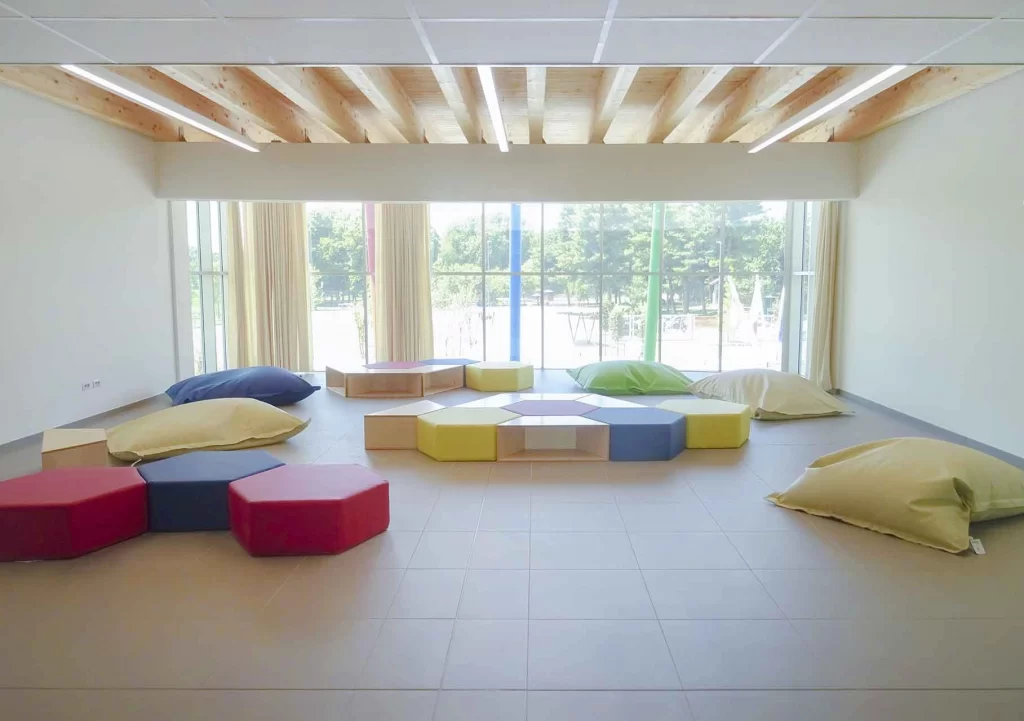
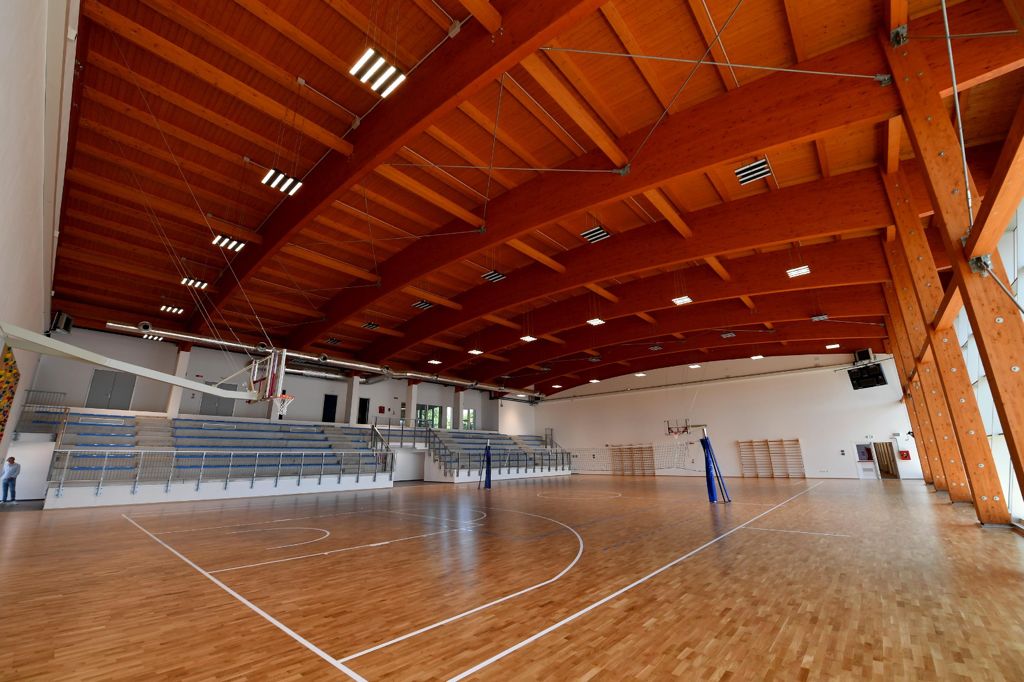
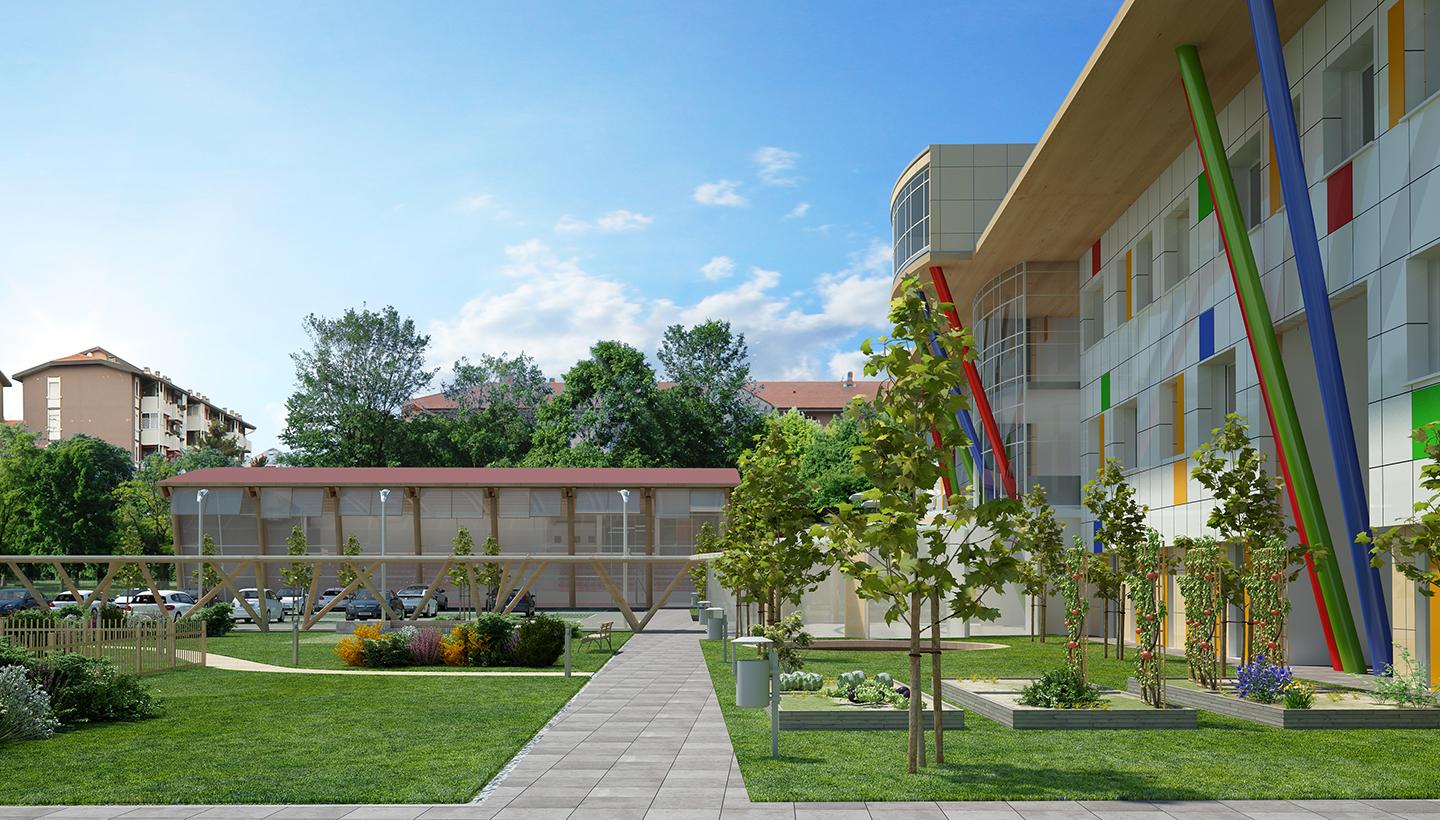
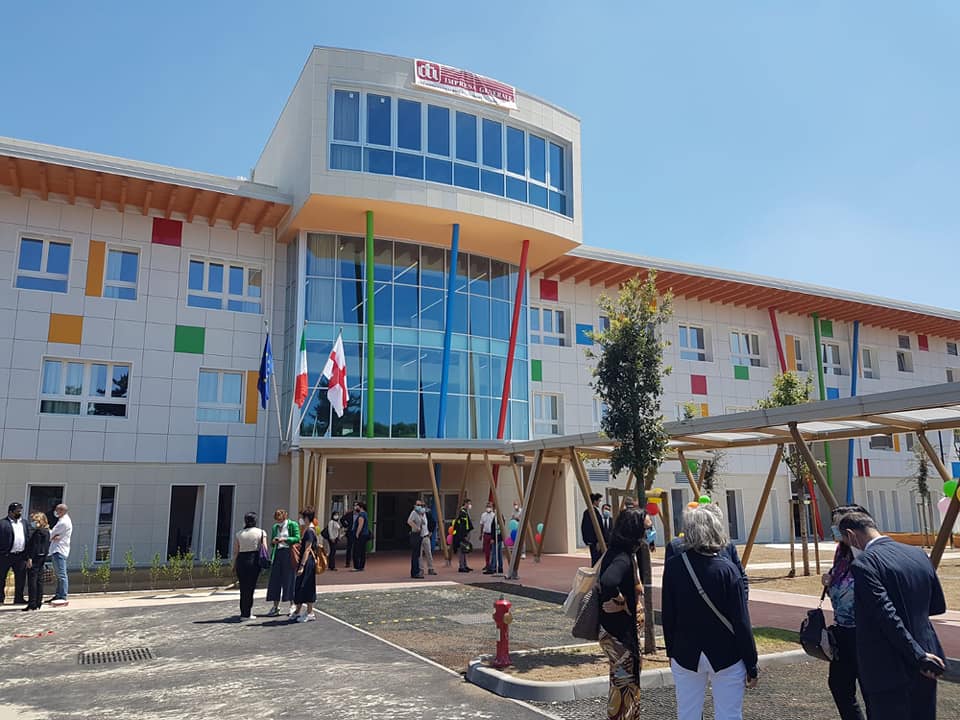
CENTRO – TEATRO LIRICO GABER | PASQUALE FRANCESCO MARIANI ORLANDI
Public – service – cultural building
The project by the Alumnus Pasquale Francesco Mariani Orlandi, reopened the doors of the opera house after more than twenty years of inactivity.
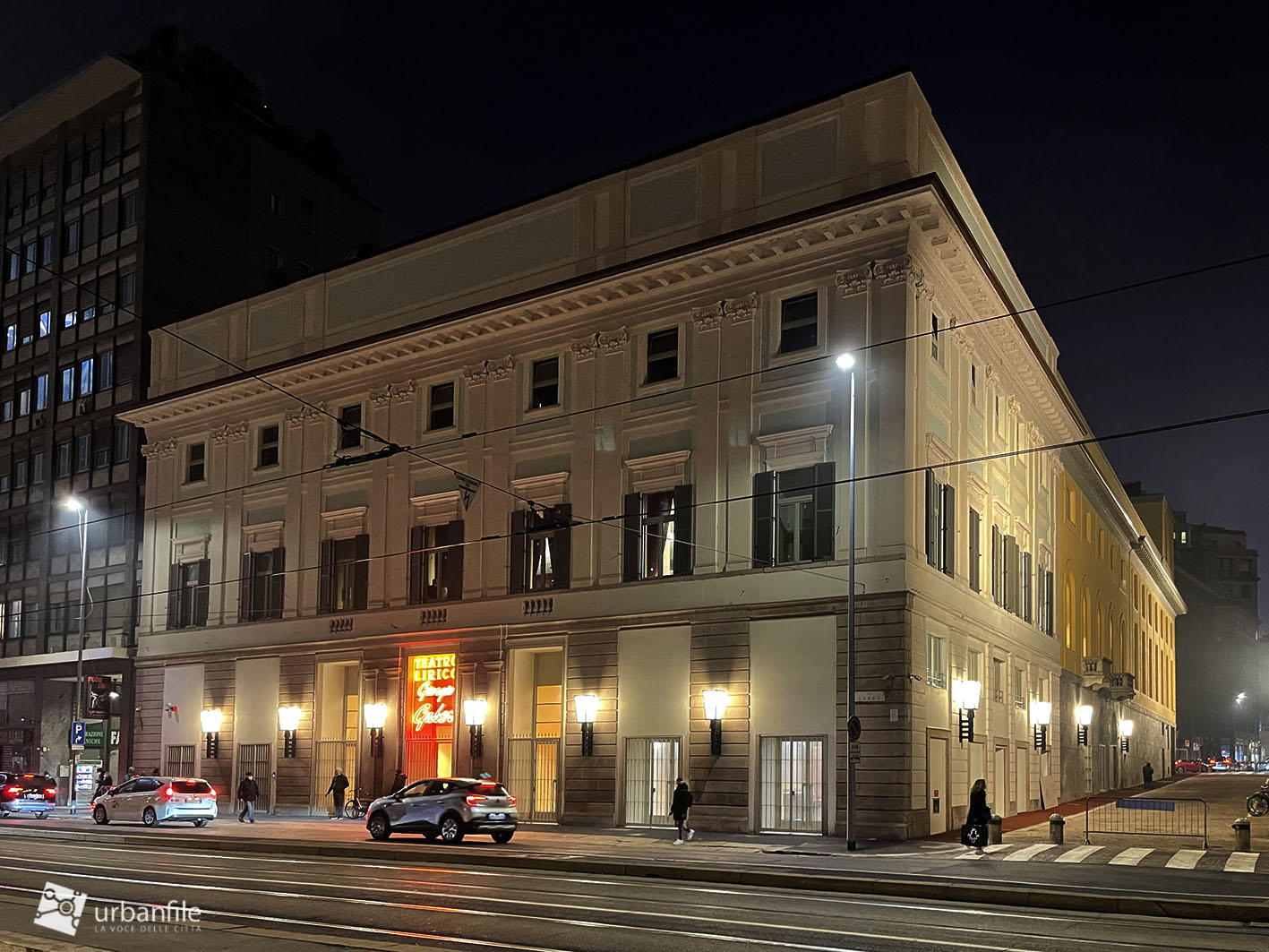
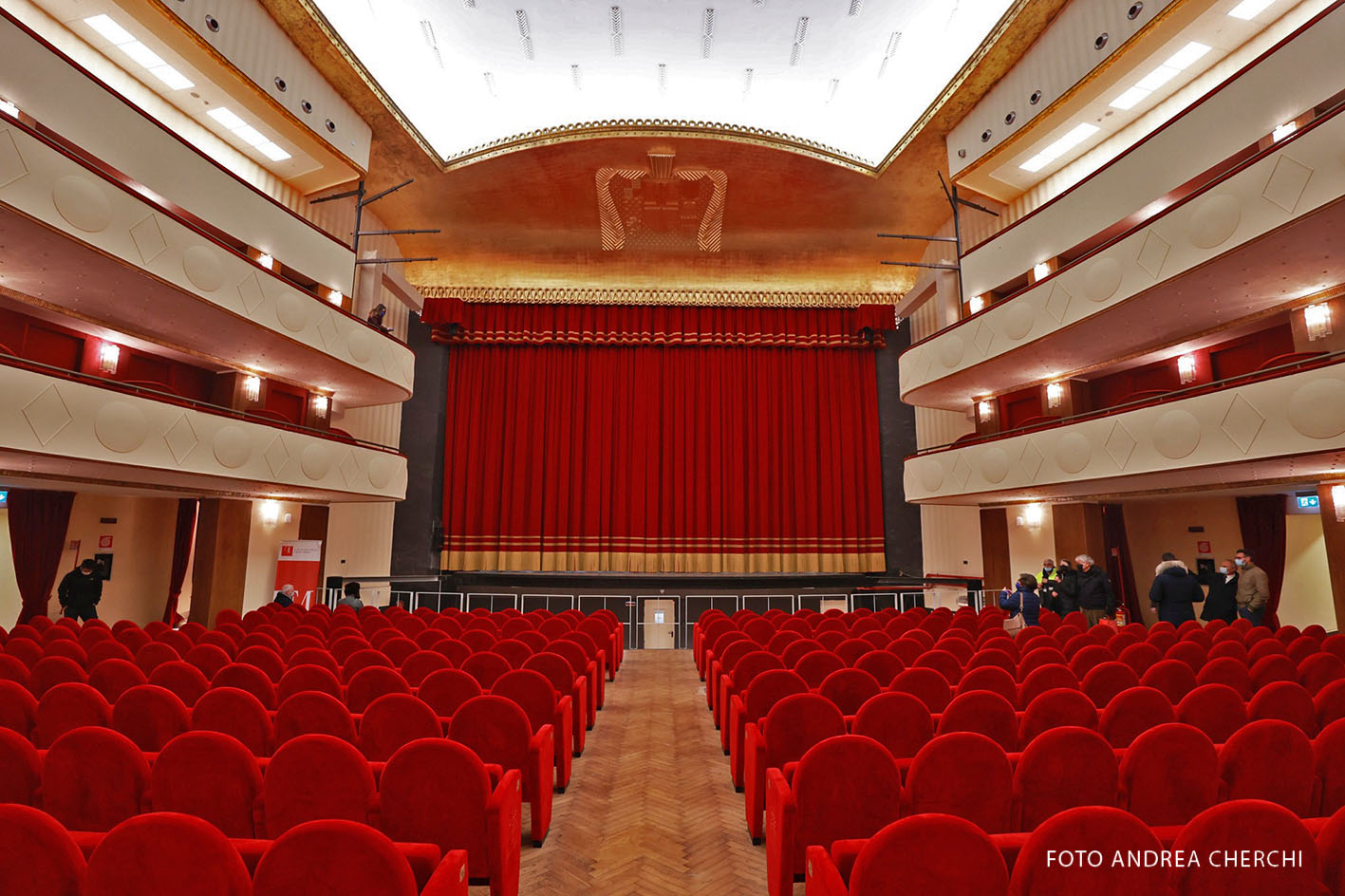
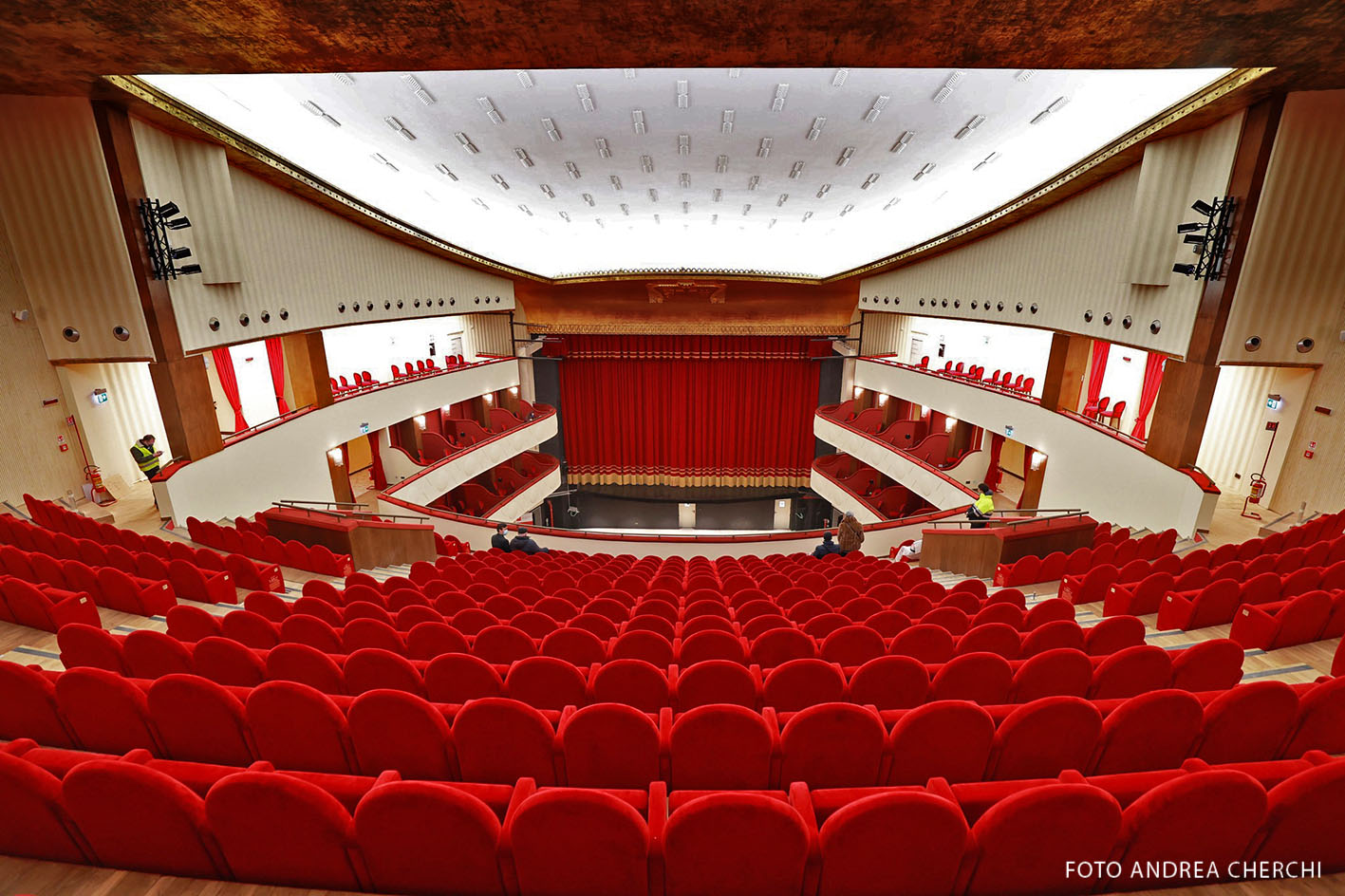
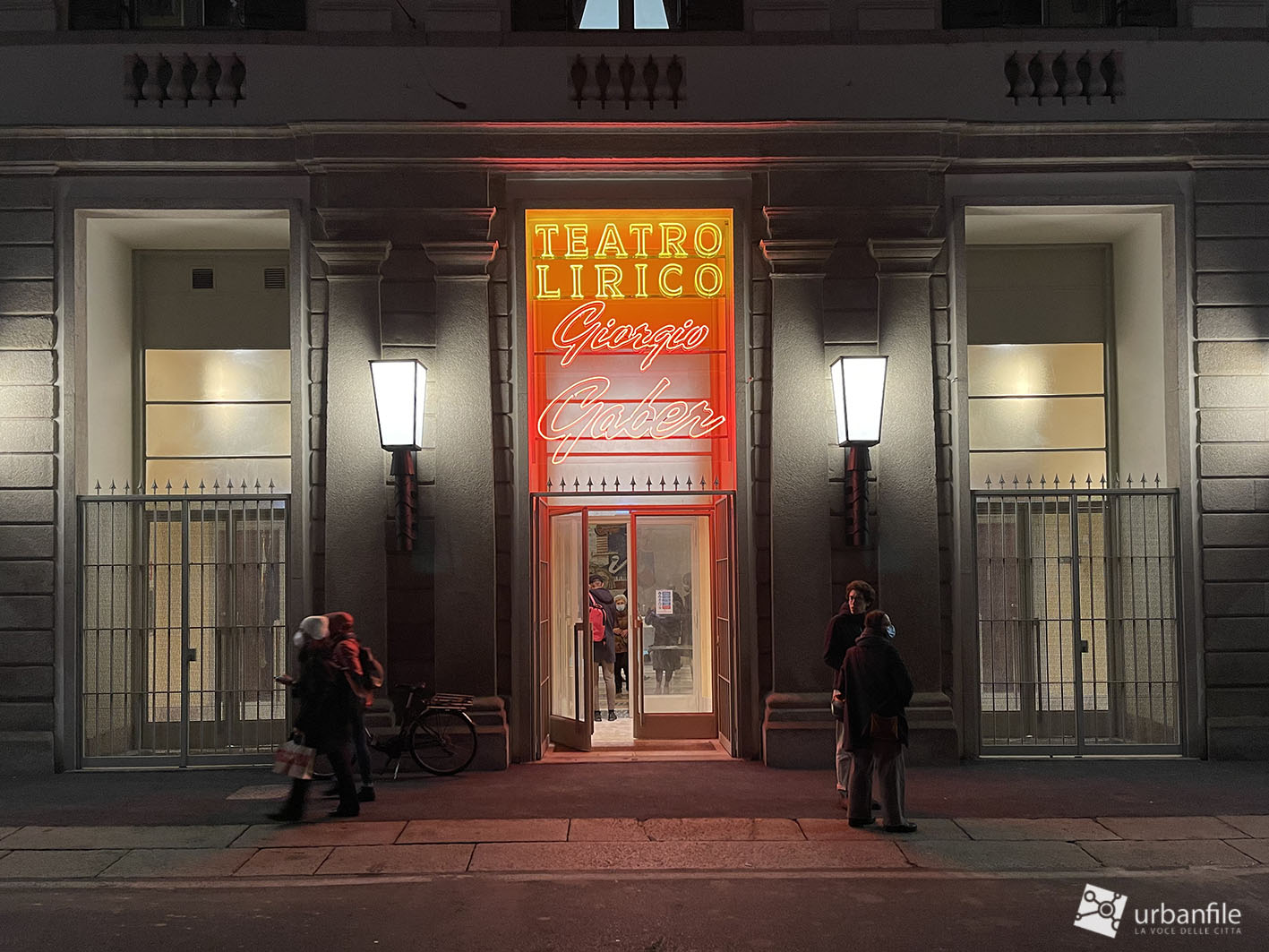
“Originally the Teatro della Cannobiana, built in 1779, one year after La Scala, the newly renovated opera house, costing €16 million, now seats 1,517 – 798 in the stalls, 505 in the gallery, 120 and 36 respectively in the first and second balconies. It also has a restaurant overlooking the stage, a 100-seat multimedia room in the foyer on the first floor and other side rooms. There are new dressing rooms and also a rehearsal room with a view of the Duomo. A people's theatre, - as described by the director Matteo Forte -, “destined to significantly enrich the city's cultural offering.”
Credits header: canva.com
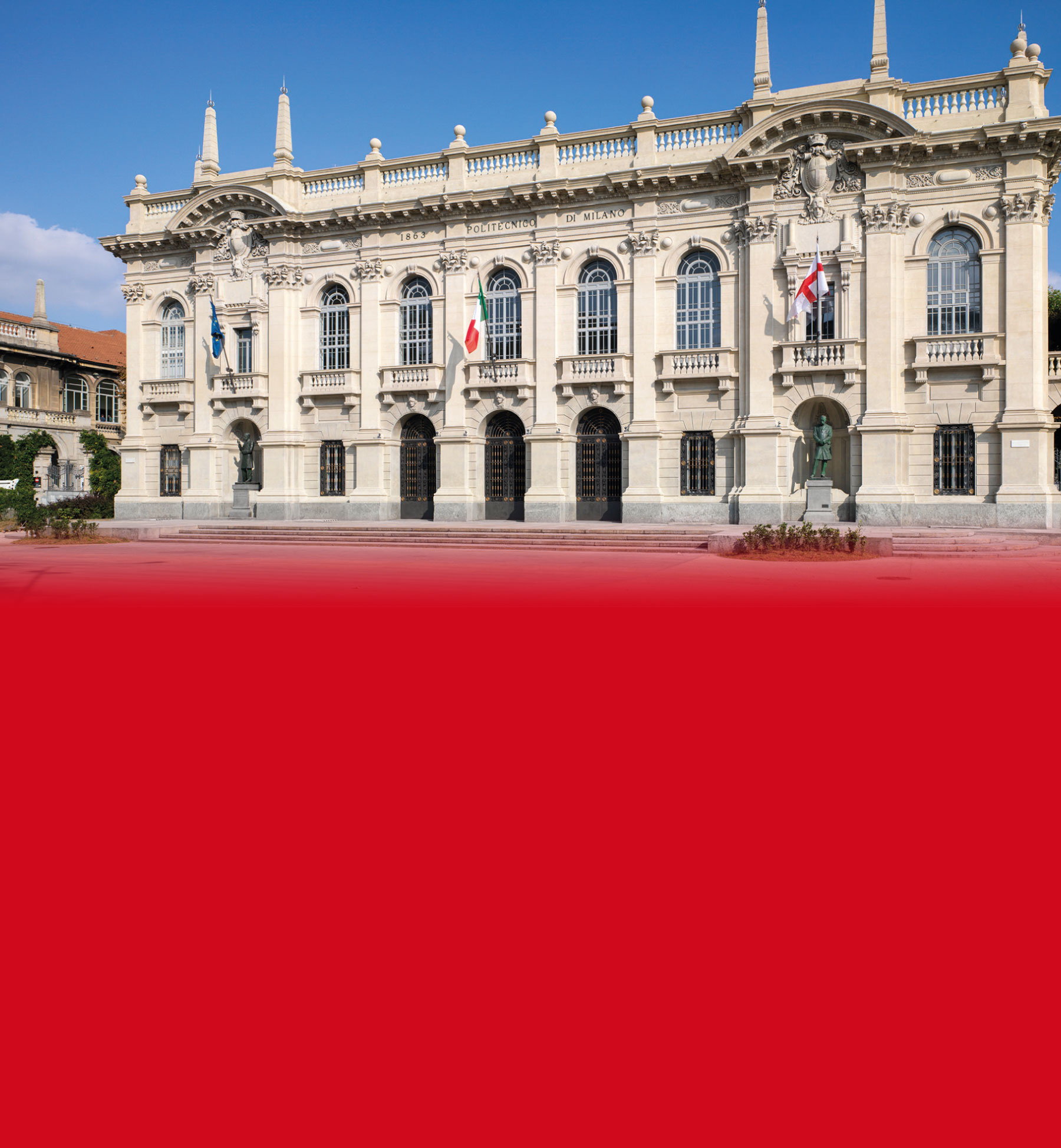
5 per mille: the Politecnico is No 1 in Italy for donations received
The data relating to your 5 per mille donations in 2020have been released for a total sum of 985.530 €, 7.921 taxpayers, mostly Alumni, donated their 5 per mille to the Poli. In the ranking of entities eligible to receive the donation, the Politecnico ranks 1st among universities, for amount of donations.
Among the research institutions, including non-university facilities, the Poli climbs three positions, from 9th (2019) to 6th place. In the last 9 years, the Politecnico di Milano has received around €5 million from donations of 5 per mille.

TOWARDS SUSTAINABLE AND RESPONSIBLE DEVELOPMENT
The University has invested these funds in high-impact social research projects, supplementing them with a part of co-funding allocated by the departments themselves or by public bodies and sponsors, according to the Politecnico’s vision of sustainable development that promotes the engagement of private and public sectors, civil society, researchers and financial institutions.
Environment, energy, health, urban regeneration, support for vulnerable populations and regions (and the list goes on) are global challenges that concern everyone and that pose questions that scientific research is called upon to answer. This commitment is part of the Politecnico di Milano’s DNA.
Funded research projects are selected each year through a research proposal competition: the Polisocial Award. First in Italy among academic initiatives of this type, it aims to support and launch research projects and an ethical approach to academic work that enhance the social impact of polytechnic skills, with a view to sustainability over time and with the goal of giving space to young researchers.
DISCOVER THE HIGH-IMPACT SOCIAL RESEARCH AT THE POLITECNICO DI MILANO
The projects funded in 2021, which started in last few months, focus on methods, strategies and tools to reduce the social imbalances aggravated by the COVID-19 emergency, favouring access to resources and opportunities by vulnerable people, groups or communities, with a view to equity and sustainability. In 2020, we focused on contexts of fragile health and the connected social consequences.
In 2020, we focused on contexts of fragile health and the connected social consequences. Going even further back, we have worked on projects examining sport as a lever of inclusion: to counteract youth malaise and exclusion of diversity, promote dialogue between cultures and promote the social and environmental regeneration of neighbourhoods. Over the years, we have talked about many more research projects in MAP, the Politecnico di Milano Alumni Magazine: discover all the projects financed thanks to your 5 per mille.


QS Ranking: Politecnico 13th in the world for engineering
The QS World University Rankings by Subject 2022, the ranking of the best universities in the world by subject area, reinforces the growth trend of the Politecnico di Milano.
In Engineering,in the last 6 years our university has climbed 11 positions in the ranking, reaching today the 13th place in the world (from the 24th place in 2016).
In Architecture and Design it has gained 5 positions : respectively, from 15th and 10th place in 2016, last year, also confirmed by the new ranking.

In Europe we are in 7th place in the Engineering area, 3rd for Design and 5th for Architecture.
Various parameters were taken into consideration while building this ranking. One of them also reflects how Alumni value their core competencies, acquired during their studies, in relation to their professional context.
The result achieved is definitely positive and we are proud of it. Not only for the reaffirmation in the fields of Architecture and Design, which are world excellences, but above all in the face of the positions climbed in engineering, a highly competitive and more difficult to positioning context for Italian universities.
commented Ferruccio Resta, Rector of Politecnico di Milano.
Compared to last year, within the Engineering macro-category, the Politecnico has gained significant positions in chemical engineering (+7 positions), civil engineering (+2), mechanics (+2),electrical and electronic engineering (+3), materials engineering (+21) and environmental engineering (+8).
A result possible thanks to very specific strategic actions carried out by our university in the last six years. Among these, the consolidation of the relationship with companies, which also passes through support for start-ups and business development, with the creation of numerous Joint Research Centers.
Academic Reputation is the indicator strongly improved and is also the most important in the ranking. In fact, it makes up at least 40% of the final assessment in the disciplines of the Politecnico, and is based on the evaluations of over 130,000 academics from all over the world.
Not a pleasant surprise, rather the well-deserved recognition of the value of the policies activated in recent years: from investments in research infrastructures to international alliances. An important indicator of our reputation and attractiveness to talented researchers and students, inside and outside national borders.
adds Resta.
In recent years, Politecnico di Milano has built a model of close alliances between the most important European technological universities, with the aim of creating a new academic space for the interaction between technological progress, society and the environment. Thanks to this internationalization process, we have managed to achieve one of our primary missions of the last three years, thus becoming one of the "European Leading Universities", capable of leading research and scientific and technological innovation to contribute to sustainable and inclusive development.
In the Italian panorama, the Politecnico di Milano is confirmed as the absolute first in Architettura, Design and for almost all engineering subjects (Computer Science & Information Systems; Chemical Engineering; Civil & Structural Engineering; Electrical & Electronic Engineering; Mechanical, Aeronautical & Manufacturing Engineering).
Our country, the seventh largest economy in the world, should aspire to have at least one university among the top ten in the world in every discipline.
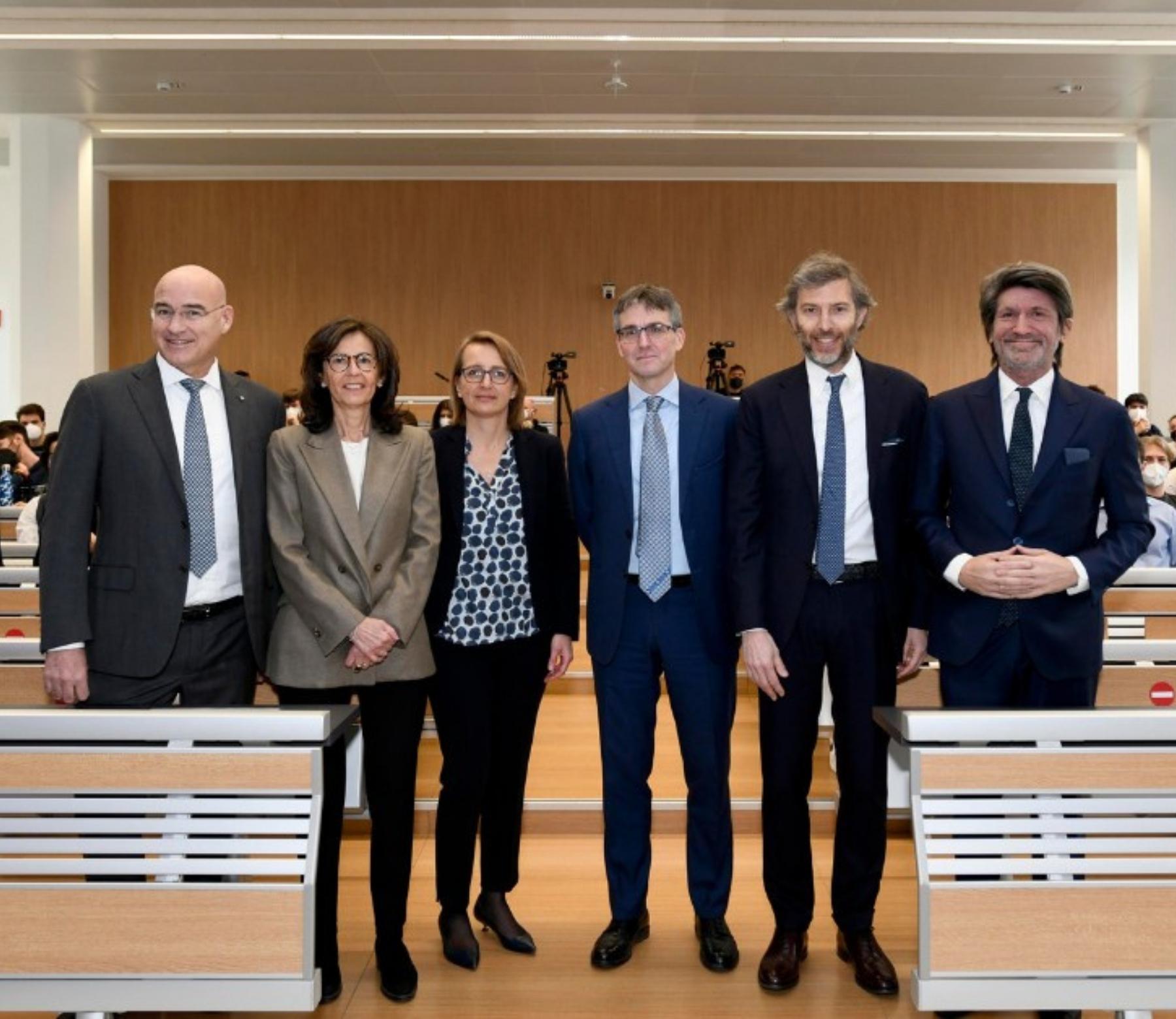
Politecnico and Bocconi together to train top sustainability managers
It was presented yesterday - at a press conference by the Rectors of Bocconi and Politecnico di Milano, Gianmario Verona and Ferruccio Resta, with the Minister of Ecological Transition, Roberto Cingolani - the new Master of Science in Transformative Sustainability, that arose from the collaboration between Politecnico di Milano and Bocconi University.
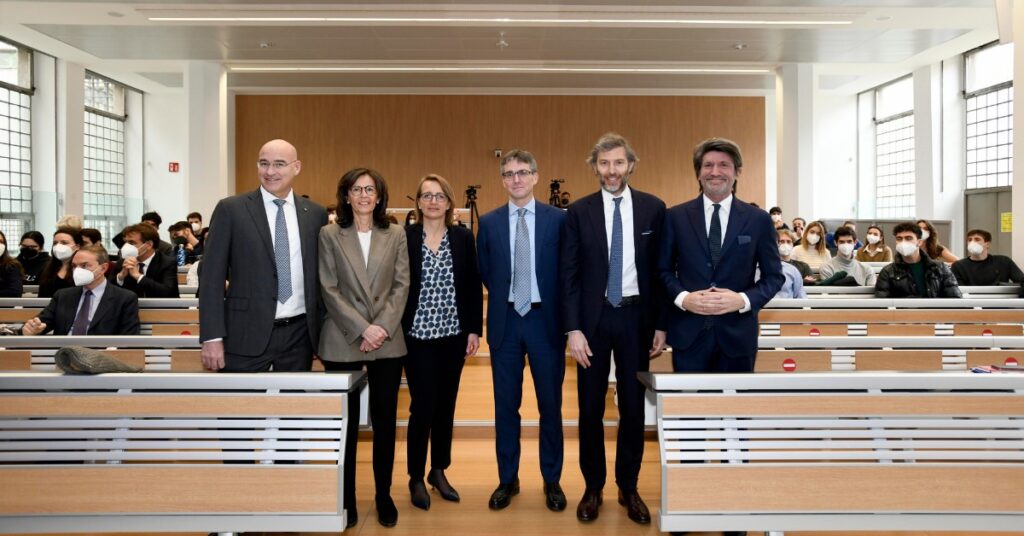
The joint programme, which will be coordinated by Raffaella Cagliano (Politecnico) and Francesco Perrini (Bocconi), is unique in the panorama of university education in Europe, because it aims to train top sustainability managers, professionals with the dual characteristics of 'manager-technologists' and with a highly integrated and innovative perspective on sustainability, in line with the needs of the market, which increasingly requires multidisciplinary skills.
"Sustainable transformation is today an essential challenge for companies Sustainability is not just one of the pillars on which plans for the Europe of the future are based, but today it must become part of the DNA of every business model so that the impact of businesses can be ever more positive. It is essential for us to train future managers who have this vision."
explains the Rector of Bocconi University, Gianmario Verona.
"Technology is, beyond a shadow of a doubt, the enabling factor of the great transformations taking place, as in the case of sustainability in all its meanings. It has a decisive impact on business processes and directs companies and public bodies towards complex development plans of which the SDGs are the founding elements. Hence the contribution of Politecnico di Milano and the need to combine the technical and training skills of our two universities on key issues for economic and social growth."
adds the Rector of Politecnico di Milano, Ferruccio Resta.
The new graduate program will see the creation of a joint teaching model, but according to the respective areas of expertise: Bocconi professors will deal with the subjects most linked to the disciplines of social sciences, management, economics, finance and law - all necessary to manage a "just" circular sustainable transition; the faculty from Politecnico will train students on the most advanced technologies , particularly in the areas of energy, environment, chemistry and mobility, as well as conferring an engineering approach aimed at designing, innovating and managing sustainable systems. The new course will include classes in data analytics and innovation processes, ethics, diversity and inclusion.
The Master of Science in Transformative Sustainability is the second M.Sc. programme developed in partnership between Politecnico and Bocconi, after the Cyber Risk Strategy and Governance programme in 2019 (we talked about this in in this news).The start is scheduled for the 2022-2023 academic year.
Support students: with a donation starting from €10 you can help fund scholarships:. Give now.


